#finlandia 2022
Explore tagged Tumblr posts
Text

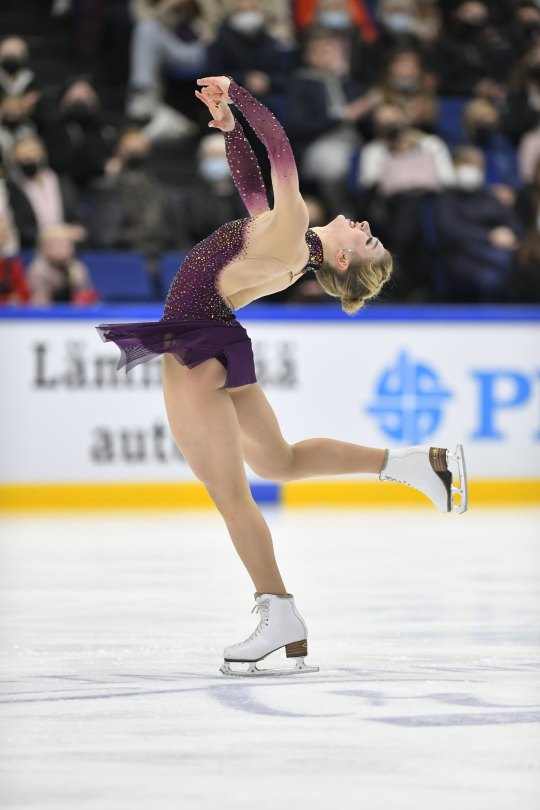
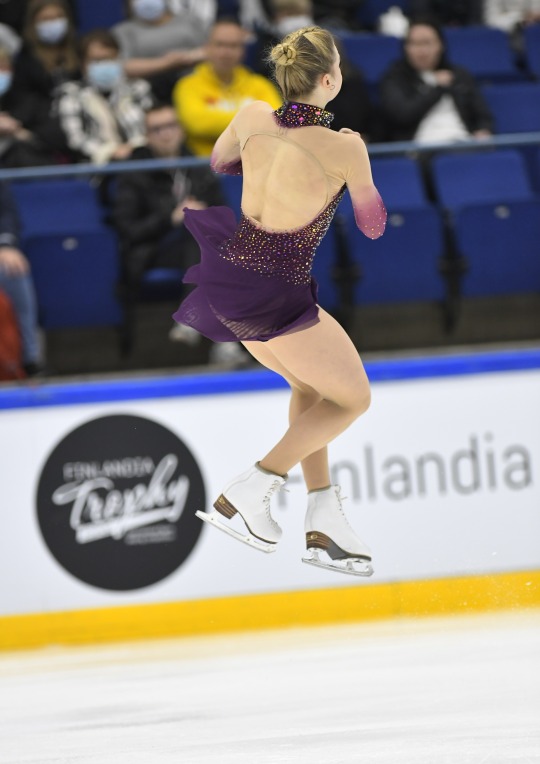

Amber Glenn competing in the short program of the 2021 Finlandia Trophy. She skated to Circles by Greta Svabo Bech (based on Einaudi's Experience).
(Source: Antti Lehto)
#Amber Glenn#Figure skating#Circles#Greta Svabo Bech#Ludovico Einaudi#Experience#2021–2022#2021 Finlandia Trophy#Women#United States#Ombre
31 notes
·
View notes
Text
LA FINLANDIA STA AZZERANDO I SENZATETTO

Negli ultimi anni migliaia di persone in Finlandia hanno abbandonato le strade in cui vivevano. Mentre in gran parte del mondo il numero dei senzatetto è in aumento, la Finlandia è l’unico Stato dell’Unione Europea ad aver eliminato quasi completamente questo problema.
La Finlandia ha adottato un nuovo approccio chiamato Housing First, affidare cioè un appartamento a persone che non hanno nemmeno un posto dove dormire. Si tratta di abitazioni collocate all’interno di condomini sociali in cui lavorano team composti da assistenti sociali, infermieri, terapisti del lavoro, psicologi e medici che forniscono assistenza 24 ore su 24 ai numerosi residenti. Da decenni la Finlandia investe nella costruzione, manutenzione e acquisto di alloggi sociali e sono stati creati più di 8.000 appartamenti per i senzatetto; un obiettivo condiviso da tutti i governi, sia di sinistra che di destra. Nella sola capitale, dal 2019 al 2022, il numero di persone che vivono senza tetto è diminuito del 40%.
Nel 2007 fu un ministro ad avere l’idea di mettere a disposizione un appartamento per tutti i senzatetto. Oggi questo modello è studiato in tutto il mondo. Di recente, il ministro tedesco per l’edilizia abitativa ha visitato il Paese per avere una visione diretta della politica di welfare finlandese. Dall’inizio del programma, Housing First ha trovato un appartamento per il 60% dei senzatetto finlandesi con l’obiettivo di arrivare al 100% e dal 2012, lo Stato ha calcolato di aver risparmiato quasi 32 milioni di euro all’anno, di cui la maggior parte nel settore sanitario.
___________________
Fonte: Housing First; foto di Myriams Fotos

VERIFICATO ALLA FONTE | Guarda il protocollo di Fact checking delle notizie di Mezzopieno
BUONE NOTIZIE CAMBIANO IL MONDO | Firma la petizione per avere più informazione positiva in giornali e telegiornali

Se trovi utile il nostro lavoro e credi nel principio del giornalismo costruttivo non-profit | sostieni Mezzopieno
77 notes
·
View notes
Text

Thank you so so much for the ask @fern-foxx, I would love nothing more than to info dump <3.
PREPARE FOR 6130 WORDS THAT WILL MAKE YOU REGRET EVER ASKING ME TO DO THIS!
First things first, I have spent the last 4 hours formatting a response to your ask, only for tumblr to turn around and shit itself, and not let me post it. So I am restarting and trying it in the form of a proper post.
I think I had too many photos and links. So have put all my links in a linktree for your and tumblr's convenience (otherwise this post couldn't happen). Will just do a number coding system.
I have only gotten into figure skating recently. It started when some friends got me to watch Yuri on Ice and it's all been downhill since then.
The competition series I've been watching is the Grand Prix. This is on from October to December and is an elite level competition.
There are 2 programs that each skater competes, and I will go more in-depth later. But basically, there is the short program which is first - this is 2:40 +/- 10sec and the free program which is 4:00 +/- 10sec.
There are 6 qualifying events across the world, and skaters will be assigned either 1 or 2 competitions depending on how well they did at World's in March as well as some other criteria.
The competitions and when/where they were held this year:
Skate America - Oct 18-20 (Allen, TX)
Skate Canada - Oct 25-27 (Halifax, NS)
Grand Prix de France - Nov 1-3 (Angers)
NHK Trophy - Nov 8 -10 (Tokyo)
Finlandia Trophy - Nov 15-17 (Helsinki)
Cup of China - Nov 22-24 (Chonqing)
These are held in the same country every year (in 2022 Finlandia replaced the Rostelecom Cup in Russia for obvious reasons). The Junior Grand Prix has 7 qualifying competitions held between August and October and the locations of these change every year.
And then there’s the final:
Grand Prix Final - Dec 5th-8th (Grenoble, France)
The final is held in a different location each year and hosts both the seniors and juniors.
There are 12 skaters in each competition, and they'll get points based of how they place. At the end of the 6 competitions, the top 6 with the most points will go to the final.
The points:
1st - 15pts 2nd - 13pts 3rd - 11pts and so on... until 7th which is 4pts and 8th - 3pts.
There are various tie brakers in place, the first 2 are highest placement and if that ties -> highest total score (the list really keeps on going there are so many in the event all the tie brakers are tied).
Okay, now you understand how the Grand Prix works, we can go a little more in depth.
The Assignments
I said that these are based off of their placements in World's of the last season. The top 12 are guaranteed 2 assignments, the top 6 of these are called "seeded skaters." These are carefully assigned so that #1, #2, and #3 don't face each other at an assignment, and #4, #5, and #6 don't face each other. You can imagine that it would be unfair to have all the top skaters at 1 competition.
I made this helpful table to show who the top 6 at World's were in the men’s category:

The first number was their total score, second their short program, 3rd their free program, and then it has their 2 assignments. Shoma Uno placed 4th but retired that season so it bumped everyone up and the free spot went to Deniss Vasilijev. I won't share my women's table cause it is a total mess with several dropping out last minute.
The top 24 on the ISU (International Skating Union) world standings and season's best list also get 1 spot. Once all of those spots are filled, there is this sketchy ‘Host Pick’ rule. The host country of a competition gets to pick 3 of its own skaters to be at its competition. This could be giving someone with 1 slot an extra assignment or giving it to a local skater to draw in crowds. But the thing is, host picks don't have to meet the minimum score requirement?!?!? More on that later...
Other things that will put you in the pool for assignment consideration - are if you medal at the junior grand prix and are moving into the senior division. Or if you are a previous seeded skater who didn't participate in the last season due to heath/injury. After that, they look at the top 75 season's best list who meet that minimum score requirement.
The minimum score requirement is different for every division and changes every year. It is calculated by taking ⅗ of top score at the previous World's. In my table you can see that Ilia Malinin won with a total score of 333.76, so the minimum score for men in the 2024 Grand Prix is 200.26. (This year it was 133.77 for women). This minimum score also must have been achieved at an official ISU event (world championships, grand prix series, challenger series).
It is also worth noting that there is a limit of 3 skaters representing the same country at an assignment. Though there can be more than 3 if they make it to the final. See this year's final being 5 Japanese Women + Amber Glenn from the USA.
Now I want to tell you about the program requirements (for single, senior skating).
The Short Program
duration: 2:40 +/- 10 seconds
jump elements: 3
spin sequences: 3
1 step sequence
Both men and women must perform a double or triple axel, and a jump combination with 2 jumps. In addition to this, men must perform any triple or quadruple solo jump, and women any triple. The solo jump has to be different from the ones in combination. Because of their body shape, men can generally make more rotations in jumps than women, barely any senior women do quads after their body changes.
Both men and women must do 1 spin with a flying entry (any position), 1 combination spin with at least 2 different types of spins (camel, sit or layback). For the 3rd spin - spin in one position, men do either a camel or sit spin with 1 change of foot, and women can do any position but no change of foot. The position has to be different from their flying spin. As for rotations, for it to count you need a minimum of 8 rotations if you are not changing your spinning foot, and 6 if you are doing a change of foot.
The step sequence is a showcase of difficult steps and turns across a large surface of the ice, usually lasts at least 30 seconds.
Spins and step sequences get a level between 1 and 4 based off how complex and well executed they are. With 4 being the best and the standard for high level competitors.
The Free Skate
duration: 4:00 +/- 10 seconds
jump elements: 7
spin sequences: 3
1 step sequence
1 choreograph sequence
Both men and women must do 1 axel at any point. There is a maximum of 3 jump combinations allowed, with 4 other solo jumps. Most of them will do a jump sequence, which is when the second or third jump in a combination is an axel. Only 1 combination is allowed to have 3 jumps, the rest can only have 2.
Only 2 triples or quads can be repeated twice, of that, you can only repeat 1 quad (but can repeat 2 triples). This is to stop people from just doing their most high scoring jump over and over, this rule is colloquially known as the Zayaking rule. Elaine Zayak did 4 triple toe loops at World's in 1982 and it was changed after then.
As for spins, for both men and women it's 1 spin combo, 1 spin with flying entry, 1 spin with only one position. Change of foot and flying entry are optional extras for all spins, there are no restrictions like with the short program. 6 rotations must be achieved in the fly spin and spin in one position, and 10 rotations in the combination.
Step sequence same as above.
The choreograph sequence needs at least 2 artistic skating movements such as the spiral, spread eagle, or my personal favourite - The INA BAUER.
The Ina Bauer

Amber Glenn (USA) Cup of China free skate 2024, my gif
You can see the blades are parallel, the leading foot faces where you're going, and the knee is bent. The other leg is straight out behind you, slightly staggered. Most of your weight is on the front foot, and it requires really good turnout in your hips. It is named after Ina Bauer (b.1941 d.2014) a German skater who invented it. Did you know that this Friday the 13th is the 10 year anniversary of her death? Catch me at the rink doing as many Ina Bauers possible. Anyways, there are 3 different types of Ina Bauer, the easiest being inside Ina Bauer meaning you are on the inside edge of your blade and go in a circle like this:

^ This is my very beginner level Ina Bauer, I don't quite have the strength/balance/flexibility to move up the Ina Bauer food chain yet, but I have only been skating for a few months and will master it one day.
There's also an Ina Bauer on a straight line. Then there’s the hardest which is on the outside edge, this is a very good example:

Cha Jun-hwan (KOR) 2023 ISU World Team Trophy free skate (1)
See his Ina Bauer goes along the outside of an invisible circle, and mine faces inside? And a straight Ina Bauer is just a straight Ina Bauer, like the one Amber Glenn is doing in that first gif. You don't have to do it in a layback position, you can just have a straight back for it to count. It's not about back flexibility but rather hip flexibility. RAAAAGH INA BAUERS, I live for them.
One of my favourite moments from this year's Grand Prix is when Kevin Aymoz of France does an Ina Bauer into a triple axel in his free program!!!! How cool is that?!?!

Kevin Aymoz (FRA) Grand Prix Final 2024 free skate, my gif
Skaters get more points on jumps if they include a difficult entry/exit, so this boosted his grade of execution (more on that later!) It's also a good example of an Ina Bauer with the straight back. Kevin Aymoz is one of my favourite skaters, he's a bit of a gay icon.
Now I will tell you about...
JUMPS
There are 6 types of jumps you'll see in professional skating. Most of them will be triples, except for the women's axels where doubles are more common. Men will do some quad jumps but very few will do the harder ones like the flip, lutz, and axel. Then there's Ilia Malinin of the USA who can do all the quads and make it look effortless. There’s also the occasional double as the second/third jump in combination or as a solo jump if something has gone really wrong. (Solo doubles aren't even allowed in a senior short program)
All jumps look the same in the air, and land on the same foot backwards with an outside edge. What makes them different is the way you take off. There are toe jumps that use the toe picks, and edge jumps which use your edges.

Diagram (2)
You can see that the figure skating blade is not flat but rather curved in a sort of arch shape. If you are leaning inwards, you'll be on your inside edge and outwards on your outside edge. The toe pick be spiky so you can stab it into the ice to launch you far and into the air. Consequently, if you lean too far forward on your skates you can trip over your toe pick and fling forward (I have done this many a time). You are also supposed to land on the bottom part of your toe pick and then place your foot down. But if you land too far forward on your toe pick you also fly forward (I couldn't walk after I fell like this on Saturday lmao).
Most skaters will jump and spin anticlockwise, so the following information applies to them. But for the few that go clockwise, reverse the lefts and rights.
The 6 jumps, separated by type are -
Toe jumps:
Toe Loop (T): Right outside take off. Entered from turn. Left leg extends back, toe pick strikes ice.
Flip (F): Left inside take off. Entered from turn. Right leg extends back, toe pick strikes ice.
Lutz (Lz): Left outside take off. Entered from a long straight 1 foot glide. Right leg extends back, toe pick strikes ice.
Edge jumps:
Salchow (S): Left inside take off. Entered from turn. Legs sweep to form / \ shape.
Loop (Lo): Right outside take off. Left leg crosses over right, X shape.
Axel (A): Left outside take off. Only jump that takes off forward. Entered from back outside edge, left leg steps forward, right legs swings through to launch you.
For counterclockwise jumpers, all jumps land on a back right outside edge. Which means for jump combinations (where your landing edge has to be your take off edge) there are only 2 jumps that can be used as the second/third in combination. These being the toe loop and loop because they take off from that right outside edge.
This is unless a Euler jump is performed. This is a single jump used in combination to connect 2 jumps as it will take you from the right outside edge to the left. Interestingly, from the 2026-27 season onwards, Eulers will no longer be allowed in the short program, only the free. They will also no longer count as a listed jump nor add any base value to jumps (currently worth 0.5).
I've mentioned jump sequences in the free program requirements, but to expand on them. They are when your take off edge is different from your landing edge. I.e a small step is done so long as it doesn't disrupt the flow. Though since the 2018-19 season, only axel jumps are allowed as the second/third in a sequence. Also prior to 2022-23 sequences would only get 80% of the total base value for the jumps, but now it's full value.
It was also only in the 2018-19 season when the number of jump elements in a men's free skate went down from 8 to 7 (women's was already 7), and from 2026-27 onwards both disciplines will be going down to 6. That same season in 2018-19 the men's free skate went down from 4½ minutes to 4.
I should have mentioned this before, but figure skating seasons are from the 1st of July to the 30th of June so they span 2 years (not really, but that’s why I am using '2018-19' etc). The season starts with the Junior Grand Prix qualifiers in August - October, then the senior Grand Prix qualifiers in October - November with the final in December. December to January is when most countries hold their nationals. January is also the European championship. February has the 4 Continents (which is everyone BUT Europe), and March is the World Championships. When the Olympics are on in Februarys the 4 Continents are moved to January.
There's also The Challenger Series which is a step below Grand Prix. These competitions are required to take place between August 1st and December 15th. There are several competitions worldwide, but they don’t have a final. Sometimes Grand Prix skaters will compete in them to boost their rankings as they count towards the season's best list and can be where you get your ISU minimum score requirement that we talked about earlier.
Redirecting this back to jumps, here is a table of base values. You can see them ordered from lowest to highest to give you a sense of what’s easier vs harder.

Speaking of base values, I think it's about time I introduced you to...
The ISU Judging System
Now this can be EXTREMELY confusing at first, but in time it will make sense, and I hope I explain it well enough.
Both the short and free scores are broken into 2 sections. You have your Technical Score (TES) and your Program Component Score (PCS).
Technical Score - every element you perform has a base value (BV) that is added to your score. This is the easy part. Now where it gets complicated is with the Grade of Execution (GOE). Each judge (there's usually 7 - 9 in big comps) assigns a number between -5 and 5 based off how well it is executed.
Now bear with me here...
The highest and lowest GOEs from the judges are discarded, and the rest are averaged. The GOE average is then multiplied by 10% of the BV. This is your final GOE for a skill, this number is then added to the original BV to give a final FINAL score for a skill.
EXAMPLE:

The quad lutz had a base value of 11.5.
The 1 and 3 are discarded. (Highest and lowest)
(2+2+3+2+2+2+2) /7 = 2.14 - the average GOE
11.5 x 0.1 = 1.15 - 10% of the BV
2.14 x 1.15 = 2.46 - total GOE
11.5 + 2.46 = 13.96 - final skill score
Personally, I love how much maths is involved!! It's fun to just calculate these things even if the score sheets give you the final skill score anyways. It is really exciting once you understand how all of this works!! (yes, I am autistic if you haven't guessed already)
I would also like to note, that the current +/- 5 GOE system used to be +/- 3 but was changed in the 2018-19 season to make improper technique and falls have a bigger impact on scores.
Now the program component score (PCS). There are 3 categories: Composition, Presentation, and Skating Skills. A brief definition of all of them: Composition is the connection of your skills, use of the ice, and understanding of how the music relates to your program.
The standout example of this that I have to show you is from Kaori Sakamoto's free skate, I just LOVE how her jump take offs are on beat to the music!
Kaori Sakamoto (JPN) Grand Prix Final 2024 free skate
She actually got the highest PCS score out of the women in the Grand Prix Final!! It's easy to see why.
Presentation is engagement and expression with your music, and I guess general prettiness? Skating Skills is "a good range of steps, turns, and movements with blade and body control" tbh, I don't have a good understanding of what these look like, I guess it’s just vibe based. This is like an artistry score. It is just as important to have graceful skating that tells a story, as it is to have good technical abilities. The judging system and jump base values are always changing to try and balance this, and there a few systems in place to make this possible too.
Before 2022-23 there were actually 5 PCS categories, the 2 they got rid of were transitions – “intricate footwork, positions and movements that link all elements”, and interpretation (of the music) which I don’t fully understand, how many categories do you need in order to judge if a skater understands the music lol. This also meant that the factors increased in 2022-23 as they axed 2 categories.
So, for each of the 3 PCS categories, the judges assign a number between 0.25 and 10, and it goes up in increments of 0.25. Just like with the GOE, the highest and lowest numbers are discarded, and the rest are averaged. These averages are then added together and multiplied by a factor.
This factor is different for every discipline, because it is supposed to be as equal to the TES as possible. The women's factor is lower than the men's because they generally have a lower TES. And the short program is lower than the free skate because there are less technical elements.
The factors are as follows:
Mens Short Program: 1.67
Mens Free Program: 3.33
Women's Short Program: 1.33
Women's Free Program: 2.67
(the factors for pairs are the same as women's)
Let's look at Kaori Sakamoto's GPF free skate as an example, specifically her composition score:

The 8 and 9.5 are discarded, and the average is rounded to 2 decimal places equaling 8.93. This process repeats for the other 2 categories. These numbers are then added together (8.93 + 8.82 + 8.86 = 26.61) and multiplied by the factor. In this case, the women's FP is 2.67, so 26.61 x 2.67 = 71.05.
The maximum PCS possible:
Men’s short program: 50.00
Men’s free skate: 100.00
Women’s short program: 40.00
Women’s free skate: 80.00
Hopefully now you have a better understanding of how the judging system works! There is a little more to it, I will go into more into detail now. If you look at the detailed results from a competition you may see various symbols/letters next to skills. I will tell you what they mean and what they do to a score:
q - Jumps landed a quarter rotation short, doesn't affect base value, but will give you a negative GOE. The 'q' was introduced during the 2020-21 season.
< - Jumps landed between ¼-½ rotations short. Results in only getting 80% of the BV.
<< - Jumps landed more than ½ short a rotation. The jump will get downgraded. A 3Lz with a << will only get the BV of a 2LZ.
e - Edge call on a flip or Lutz. Remember how the flip takes off from an inside edge and the lutz an outside edge? Well, if you do it from the wrong edge, you will get an edge call and only 80% of the BV.
! - Edge warning. This means there was an unclear edge take off on a flip or lutz. There is no reduced BV, but the GOE will be less than 0.
V - For a spin that does not meet requirements, like a lack of rotations or variation in position. 75% of BV.
F - A fall. -5 GOE. There is also a -1 deduction for your first and second fall, a -2 for third and fourth, and -3 for 5th fall onwards.
+REP - Used if you do more than the allowed 3 combinations or 2 combinations + 1 sequence in the free program. The first jump will get 70% BV and everything after that doesn't count. It is also used for repeated single jumps; they'll also get 70% of BV.
+COMBO - You will see this in the middle of a combination. It happens when the skater steps out after landing a jump and still takes off for the next jump. Remember the point of a jump combo is to take off from the same edge you land on. This results in the following jump having no value.
* - Invalid element, skater receives 0 points. This is for any element that breaks a rule. Like a single or double solo jump in the SP, an extra jump element done (only 3 in SP and 7 in FS allowed), repeating a certain triple/quad jump in the FS more than twice, if there is no axel done, the last jumping pass will be invalid too. Also used alongside +REP to invalidate extra jumps in combinations. Before 2016-17, an invalid jump in a combination would invalidate the entire combination. And from 2026-27 onwards, the same type of jump can't be included in the FS regardless of rotations (currently more than 3 of the same jump can be included if you do 3 triples and a double for example).
x - This is the only good symbol! It is placed after the last jump element in the SP or the last 3 jump element in the FS (provided they are in the second half of the program). It adds an extra 10% to the BV of your jumps. As the program goes on skaters will get more tired so are rewarded for doing difficult stuff at the end. Consequently, this system was heavily abused until a rule change in the 2018-19 season. It used to be that all jumps in the second half would get the extra 10%. You can then imagine people would just stack their programs to have all the jumps in the second half. This was then changed to better balance program composition.
There are also other deductions besides falls. It's -1 for every second up to 5 that your program goes overtime. -1 for costume parts falling on the ice, -1 for costumes that don't meet requirements, -1 if you take more than 30 seconds to get into your starting position after your name is called, -2 for illegal moves (back flips were recently legalised, if you want to watch programs with back flips, I recommend Adam Siao Him Fa of France).
If you do want to watch figure skating, I will quickly explain what the thing in the top left corner is. It's relatively straight forward

The squares at the top represent the 12 elements that make up the free skate (short program will have 7 squares). The green means they successfully performed an element, the red means they performed it, but it got a negative GOE. Now you also know what it takes to get a negative GOE thanks to the information above ;)! If there is a dark grey, it means it’s under review still (?). This bar will fill up as they go through the program.
It will tell you the most recent element performed, as well as the BV for it, and their GOE. This is the GOE after that multiplying the average by 10% BV nonsense. Under this you'll see the skaters TES go up throughout the program, and underneath it is the leader's TES.
AND THAT CONCLUDES THE ISU JUDGING SYSTEM, THAT WAS A LOT BUT HOPEFULLY YOU GET IT NOW!
I will also share with you a helpful table I made in preparation for watching the Gran Prix Final. It has the finalists with their assignments, how they placed with qualifying points, and their total score earned in both assignments. As well as their personal bests and age. Interestingly, the men and women have the EXACT same average age of 21⅔. Which is super interesting cause usually the women tend to be younger than the men. Though this year the minimum age for the senior division was upped to 17. Last year it was 16 and before that it was 15 for quite a while. This was to protect minors more because of how intense it got with doping etc. I think it's a great change because I don't want to see tiny children when watching seniors, its also unfair cause the younger women can go hard out and learn quads before their body changes which is dangerous.

Adam Sia Him Fa qualified in 4th but had to drop out because of injury, Mikhail Shaidorov was 7th so he got moved up to replace Adam.
I really love looking up the skater's profiles on the ISU website, because some of them have the most insane listed hobbies. Check out Camden Pulkinen. Emo ass king.

Now I want to tell you about some of my favourite skaters!
Kevin Aymoz - France

Kevin Aymoz (FRA) Grand Prix Final 2024 gala exhibition, my gif
I have talked about him before. I love how dramatic his programs are, they have a lot of flair and camp energy. He was at Skate America and Finlandia Trophy and made it to the final! Unfortunately, he fell a few times and came last. He did get bronze at the 2019 GPF though! Did you know in 2021 he was in a French documentary called Faut qu'on Parle (we need to talk). It's about 6 elite athletes who come out for the first time and share their experiences of being queer. One of his listed hobbies is "catching pokémon" okay icon.
Amber Glenn - USA

Amber Glenn (USA) Grand Prix de France 2024 gala exhibition, gif credit below
LOOK AND HOW GORGEOUS AND HOT SHE IS. First off, SHE WON THE GPF CAUSE SHE'S SO AMAZING. Her assignments were Grand Prix de France, and Cup of China. Amber is a mental health advocate who is also queer and has ADHD, I love her so much. At the end of competitions, they will sometimes hold a gala exhibition. This is a showcase that some of the competition skaters partake in. It's a chance for them to do whatever program they want without the pressure of being judged - it's truly just for fun! Amber’s gala this year was to HOTOGO! Would definitely recommend checking it out. Here are some gif sets of it here on tumblr (3 4 5). Her hobbies are Magic the Gathering, anime, and cosplay. (It's funny cause when a skater lists anime as a hobby, you just knowwww they've seen Yuri on Ice. In this case, Amber worked with the creative team on the movie before it was cancelled). She was also the second American woman to land a triple axel at World's, the first ofc being Tonya Harding. Amber is a little bit of a legend, at age 25 she's kind of come out of nowhere and is starting to skate really well consistently. It was so cute when she found out she won the GPF. There's a camera where they can see the other skaters in the back, and the Japanese women did her FS finishing pose. It was such a sweet moment of amazing sportsmanship between these women. I will put a link to the clip posted on reddit here (6).
Matteo Rizzo – Italy

Matteo Rizzo (ITA) NHK Trophy 2024, my gif
Assigned - NHK, and Cup of China. He's just a silly guy. For starters, his SP music is a song called "Two Men in Love" an extremely gay love song. But then his FS music is.... "Fix You" by Coldplay? It's the contrast that I find so funny. His hobbies are Formula 1 and "airplanes" I too love planes. All of these things combined made him stand out to me as a bit of an icon. He also kind of looks like Christophe Giacometti from YOI, he's got the eyelashes for it. The gif is from the kiss and cry after his skate when he did this super funny gesture that absolutely sent me. What can I say, the man loves cars.
Jason Brown - USA

Jason Brown (USA) NHK Trophy 2024 short program, my gif
Skate Canada and NHK. Did you know that he came out as gay on Dan's birthday in 2021? My friends and I joked that Brown was fitting name cause he was dressed like a shit for his SP in that gif. I call him JJ if he slayed, cause his energy and mannerisms + the way he addresses the audience reminds me JJ from YOI but if he were gay. Also has a super camp gala exhibition, and won the junior GPF in 2011.
I love the galas that have a gimmick. Like Mikhail Shaidorov who did a Kung Fu Panda one in a giant panda suit. He somehow managed to land a triple toe loop in that costume too! Mikhail is a really good jumper. This season he made history by becoming the first skater to land a quad as the second jump in combination with his 3A + 4T!!!
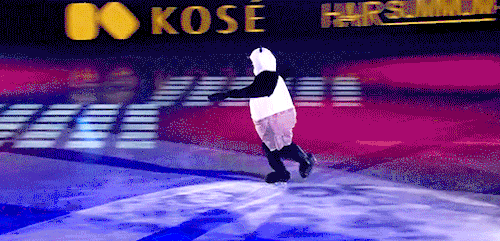
Mikhail Shaidorov (KAZ) Grand Prix Final 2024 exhibition gala (7)
He also has assistants come out in his gala and for the Grand Prix de France, Amber was one of them!
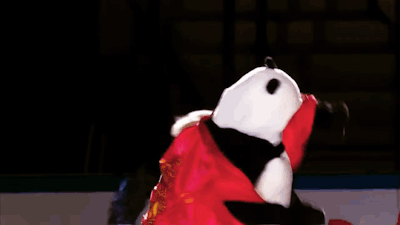
Amber and Mikhail Grand Prix de France 2024 exhibition gala (8)
Where you can watch the ISU stuff will depend on your country. I can watch it all for free on the ISU Skating youtube channel since I am in New Zealand and no other broadcaster covers it. The youtube videos are geo blocked in countries that have networks with a monopoly over the rights.
If you are also a fan of Yuri on Ice, I have some cosplay content recommendations too (if not, just skip this). I have fallen IN LOVE with these 2 particular cosplayers (Vehn and Svatti - yt channel: Weeb Chapel) who had a YOI skit series, here is the playlist on youtube (9). Svatti who plays Yuri also does a hilarious Chris which you can see in their Kiss Marry Kill in Character (10).

Cosplayer Svatti as Christophe Giacometti in "Yuri!!! on Ice KISS MARRY K-WORD!" youtube link in linktree, my gif
Svatti's Chris is also in the background as a voice in the Viktor and Yuri Google Questions Interview (11). Now I don't usually consume Otayuri content cause I find their age gap weird, but they have a gorgeous Otayuri CMV (cosplay music video) that I keep on watching (12). I have also started just watching all their other cosplay content. YOI is the only anime I've seen, but I really just love Svatti and Vehn (former username Mishkali) so much I'll watch anything with them. They are so attractive, and my gender envy is off the charts with everything they do, and Vehn’s Victor drives me fucking crazy in the best ways possible THE ACCENTTT. If you know of them or watch it and want to chat HIT ME UP!
My favourite CMV however is this one (13) by Rintamasuunta. The production BLOWS MY MIND DUDE. Even if you haven't seen YOI you should still watch it. The sets, costumes, choreography, ah too good. One of them is even an actual skater and you get to see them do parts of the routines in costume! I keep rewatching it time and time again.
One last Yuri on Ice thing - Joel Minas on youtube has recreated some of the programs in full. It is just so impressive to see them bought to life. Here is his playlist (14)
And there we have it folks!! There's a lot more that I could have included, I have so many more thoughts. I'm sure y'all are familiar with the feeling of being in the trenches of a hyper-fixation. You ask for an info dump; you get an info landfill that took a couple days and many MANY hours to assemble (WORTH IT!). I may or may not have taken it a bit too literally when you asked to hear what I've learnt so far WELL HERE IS EVERYTHING. Are you regretting your life choices yet? If you or anyone else has any questions or wants to discuss figure skating, CONTACT ME PLEASE I LOVE TO YAP (evidently)!!! Also, if you have managed to read all of this you are insane, and I love you.
I still spend most of my days thinking about skating. I am at the rink 2-3 times a week and have started lessons. I hope to get really good at it someday. Researching competitive figure skating is so so so fun! I just love learning about the all the rules/the technical side. I have so many pages of notes. Finally, I will link some resources I found helpful if you want to do some further reading.
They’ll be in the linktree (sorry it had to be like this, tumblr just couldn’t take it) https://linktr.ee/pissterdaniel
Resources
15 Brilliant youtube video that breaks down the 6 jumps with examples to help you identify them
16 The soyouwanttowatchfs website has a lot of guides for people getting into figure skating
17 ISU Technical Panel Handbook 2024-25
18 ISU Technical Rule Book 2024 (160 pages of goodness)
19 Table of base values (a couple of seasons old as still has 5 PCS categories listed, but should (?) still be valid, it has +/- 5 GOE so is after 2018 but before 2022. I feel like one of those people who works out the date a globe is from, which honestly, I’d be into because I love geography (it’s the darn autism again isn’t it)).
20 Extremely detailed table of base values 2024
21 Short program outline
22 Free skate outline
23 The ISU website in general, good for detailed scores and skater profiles
Lmk if there are any issues with the links OR IF YOU HAVE ANY QUESTIONS OR COMMENTS, I'VE SAID IT BEFORE AND I’LL SAY IT AGAIN PLEASE CONTACT ME
Okay that is it, I just want to get this out there now, getting this from my word document to a successful tumblr post has taken 7 hours dear lord.
Hope this is a sufficient info dump @fern-foxx, it’s 6130 words. Thank you for your ask xxx
13 notes
·
View notes
Text
Fun With Jump Arm Variations
When jumping, different skaters put their arms in different places, but generally they are pressed flat against the torso, especially on higher-revolution jumps. This compressed shape increases the skater’s rotational speed, which is important for attempting triples and quads.
But as anyone who has watched much skating has seen, you can jump with your arms in different positions, too. There are two main arm variations you will see in modern skating programs:
One arm above the head - these are nicknamed ‘tanos’ after Brian Boitano, who did not invent but did popularize the variation. Ones where the arm is bent a lot may be derisively nicknamed ‘helicopter tanos’, as some fans don’t like how they look. (Brian Boitano 1988 Olympics SP, Brian Orser 1988 Olympics SP, Petra Burka 1965 FS, Wendy Burge 1976 Olympics FS, Ekaterina Kurakova 2022 Euros FS)


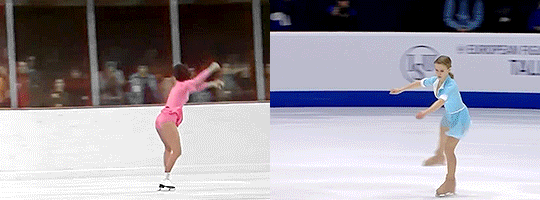
Two arms above the head - these are nicknamed ‘rippons’ after Adam Rippon, who also did not invent them but popularized them when he started doing it on his lutz. (He did tanos on it for a while, but then started using both arms when he trained with Brian Orser, because he felt bad doing ‘tanos’ in front of Orser, who famously took silver behind Boitano at the Olympics.) (Adam Rippon 2016 GP France FS, Midori Ito 1988 Olympics SP, Ting Cui 2018 JGP Ostrava SP, Sihyeong Lee 2021 Nebelhorn FS)


However, there are also other arm variations. These are all rare nowadays, although if you watch older programs, you are more likely to spot a variation that’s not a tano or rippon. Ones I’ve seen include:
Hands on hips - these used to be much more popular back in the day but have fallen out of fashion. I would guess it’s because they slow down rotational speed too much, as every one I have seen is a double except this one by Michael Chack, but I don’t know for sure. (Jill Trenary 1990 Worlds FS, Michael Chack 1992 USNats FS, Rory Flack 1988 USNats SP, Tonia Kwiatkowski 1988 USNats SP, Midori Ito 1987 Worlds SP, Anna Kondrashova 1988 Olympics SP, Yuzuru Hanyu 2010 JPNats FS)

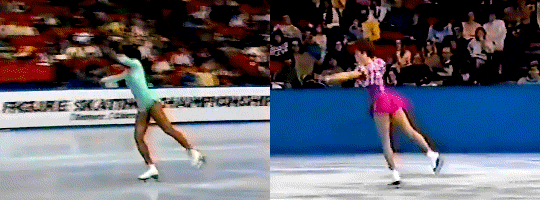

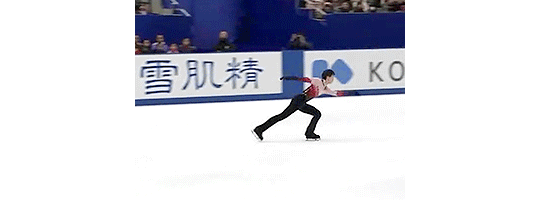
Helicopter arms - this one has been used as a warm-up by Yuzuru Hanyu, and I’ve spotted it in competitions a couple of times with single and double jumps (Rory Flack 1994 US Open Artistic Program, Yuzuru Hanyu 2012 Finlandia Trophy SP warmup)

Arms behind back - I’ve only seen this one performed by Jason Brown in his Riverdance program, where depending on the event he placed either one or both arms behind his back during the second jump of this combo (2013 SA FS, 2014 Nats FS)

Arm switching midair - I’ve only seen this one in this lovely axel variation by John Curry (1976 Olympic SP)
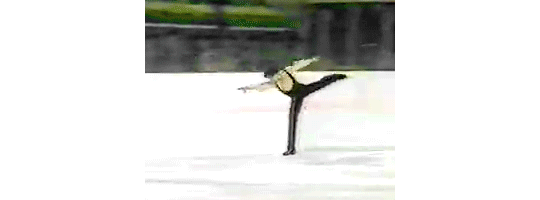
Hands by the head - I believe I may have seen this used by at least one other skater, but the only example I have at hand is this one by Nancy Kerrigan (1990 Goodwill Games SP)

Beginning in 2009, ‘varied position in the air’ became a positive GOE bullet point for jumps. This was because they are supposed to add to the difficulty of a jump, although I’ve seen arguments back and forth from skaters about how true that is for some arm positions (and even if which arm is raised makes a difference for tanos). Years later, they exploded in popularity, particularly in the women’s competition. The trend had its beginning around 2014 or so; the previous season, junior World medalists Evgenia Medvedeva and Serafima Sakhanovich were given programs constructed to include raised arms on a couple of jumps, which wasn’t too unusual, but in 2014, their programs contained many more of them. Medvedeva would go on to dominate the senior circuit for several years and notably used raised arms on most of her jumps during that time, which started the trend in earnest among other skaters.
This GOE bullet point was removed for the 2018-2019 season. But if arm variations no longer get that bit of GOE, why do we still see them so often? There are probably a few reasons:
Skaters who trained them for GOE a few years ago got used to doing them that way and don’t want to mess with their muscle memory
They can add to a program aesthetically
Skaters and their teams may still hope to impress the judges by using them
Skaters have said that rippons help straighten their jump axis
I’ve also seen speculation that rippons can be used to help muscle jumps using the upper body in some cases
I would also like to shout out arm variations on jump exits that aren’t the standard check-out position. These aren’t as common as mid-air variations nowadays and rarely get talked about as their own thing - probably in part because they were never a GOE bullet - but they can add difficulty to the exit as well as give a nice choreographic touch to a program. You can see a few in the above gifs, but here’s a few more:

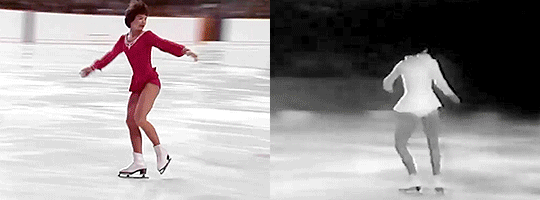
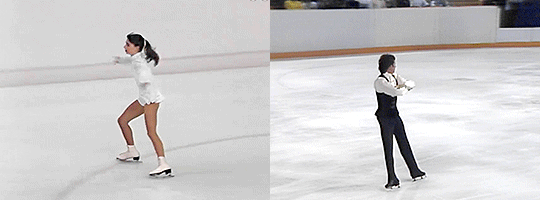
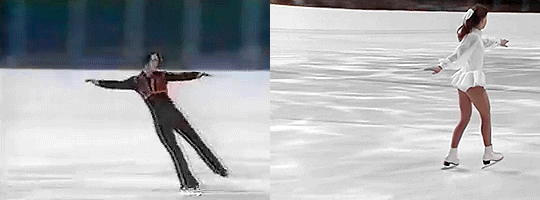
(Petra Burka 1965 Worlds FS, Yuzuru Hanyu 2021 “White Nights” EX, Anett Pötzsch 1976 Olympics FS, Hana Mašková 1968 Worlds FS, Claudia Kristofics-Binder 1976 Olympics FS, Brian Boitano 1988 Olympics SP, Vladimir Kovalyov 1976 Olympics SP)
#figure skating#fskateedit#fs history#Yuzuru Hanyu#Midori Ito#Brian Orser#Brian Boitano#Jason Brown#John Curry#Adam Rippon#Rory Flack#Ekaterina Kurakova#gifs#I went kind of crazy on the gifs here#long post
207 notes
·
View notes
Text
Primavera di libri

Torniamo a suggerirvi nuove letture e film “raccomandati” dai vostri bibliotecari di fiducia.
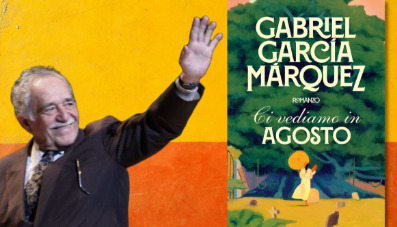
Un autentico caso letterario l’inedito di Gabriel García Márquez Ci vediamo in agosto, che, come narra la leggenda a proposito dell’Eneide di Virgilio, l’autore avrebbe voluto distruggere: “un omaggio alla femminilità, una storia di libertà e di desiderio che non si sopisce con l’età e nemmeno con l’amore coniugale”. I figli hanno consentito la pubblicazione di questo breve romanzo, che esce in contemporanea in tutti i paesi e ci delizia come una sorpresa inaspettata, nonostante la volontà del suo artefice, forse troppo esigente con sé stesso.
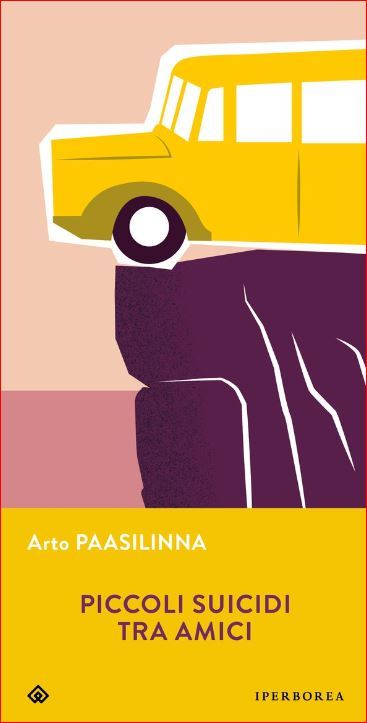
Tutt’altro che deprimente, Piccoli suicidi tra amici di Arto Paasilinna è ormai diventato un classico. Scritto con stile quasi cronachistico, la sua apparente freddezza (che peraltro ben si addice alle gelide lande della Finlandia da cui provengono i personaggi del libro) non fa che accrescere l’ironia, magari un po’ macabra, di cui è pervaso. “… ogni giorno è per ciascuno sempre il primo della vita che gli resta da vivere, anche se siamo troppo occupati per rendercene conto” è la sintesi filosofica di un romanzo divertente, originale, che si risolve in un inno non banale alla vita, alla solidarietà, all’amicizia. Un vero toccasana “per tempi agitati”, citando Mauro Bonazzi, come sono quelli in cui ci troviamo a vivere. Dalla postfazione di Diego Marani: “Una delle cose più belle dei romanzi di Paasilinna è che dopo il tumulto, il fragore e le spericolate rincorse tutto si risolve delicatamente, come una risata di cui resta solo il gioioso ricordo, nell’acqua increspata d’un lago, nel vento della sera, nell’odore di foraggio appena tagliato. … In questo libro la grande beffata è la morte”.
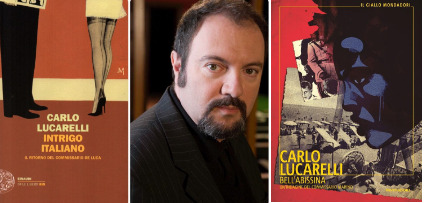
Ambientato a Bologna durante le festività natalizie tra la fine del 1953 e l’inizio del ’54, Intrigo italiano di Carlo Lucarelli ci ripropone la compagnia del commissario De Luca, sempre ombroso, inappetente e drogato di caffeina. Lo accompagna un giovane poliziotto che lo introduce negli ambienti musicali degli amanti del jazz, di cui era appassionato un noto professore morto in circostanze non chiare. Ma il mistero si infittisce quando anche la vedova viene trovata uccisa e De Luca stesso è controllato dai Servizi Segreti. Non siamo più in tempo di guerra mondiale, ma di guerra fredda e anche i migliori si devono aggiornare. Un giallo di classe, con una ricostruzione storica sempre molto accurata. È del 2022 il ritorno del commissario Marino, segretamente ma attivamente antifascista, in Bell’abissina, dopo l’esordio del 1993 con Indagine non autorizzata, quando era ancora soltanto ispettore. Si tratta di un cold case soltanto apparente, perché la serie di delitti, legati da somiglianze via via sempre più chiare, si protrae dal passato al presente pericolosamente minacciato dall’imminente scontro bellico. Marino ha un temperamento diverso da quello di De Luca e si getta anima e corpo in questa indagine che coinvolge corrotti fiancheggiatori del regime. Un incontro, come dice l’autore stesso nei Ringraziamenti, tra la storia, con la s minuscola, frutto di fantasia, e la Storia, quella del secondo conflitto mondiale che Lucarelli conosce molto bene e che ha trattato anche in diverse trasmissioni televisive.
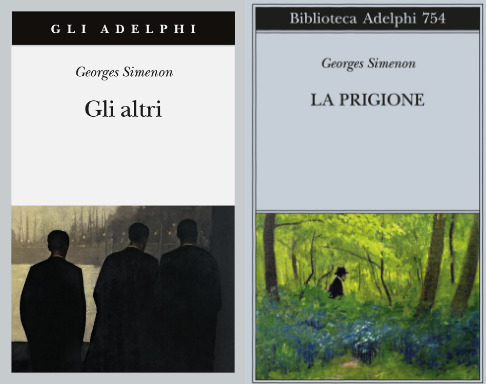
Irresistibile la doppietta di Simenon che vi proponiamo. Gli altri, inedito in Italia fino alla pubblicazione di Adelphi del 2023, è scritto in forma di diario-confessione e ci guida con il suo ritmo irresistibile tra i meandri di un suggestivo castello francese, che racchiude, ça va sans dire, una morte misteriosa, una giovane e affascinante castellana, nonché un burbero e attempato maggiordomo, sospettosamente depositario di ogni segreto… Come sempre, con pochi abili tratti l’autore descrive una serie di personaggi che non potrebbero essere fra loro più diversi, anche se appartenenti alla stessa famiglia: la sua penna riesce a far sembrare del tutto naturali e accettabili legami apparentemente inconciliabili e al limite della moralità. Il finale è riservato all’apertura del testamento: a chi andrà la cospicua eredità del vecchio Antoine Huet? Ma soprattutto: in che modo la ricchezza influirà sulla vita e le abitudini dei protagonisti? A voi il piacere di scoprirlo. Il romanzo La prigione inizia ex abrupto con un misterioso omicidio, su cui la polizia indaga. Ma duplice è la ricerca intrapresa dall’autore: da una parte il movente del delitto, dall’altra la psicologia del protagonista, costretto a scavare nella sua vita per scoprire su sé stesso e sulle persone che gli erano più intimamente vicine segreti che ignorava o che, più probabilmente, cercava di rimuovere per superficialità, paura o inadeguatezza. Così la prigione diventa una metafora per descrivere una vita fasulla che implode in un solo istante di un giorno d’autunno. Al di là del caso limite rappresentato dal fatto di sangue e delle inevitabili differenze di carattere, è talmente accurata l’analisi psicologica che ogni lettore potrebbe ritrovare qualcosa di sé nell’indole del protagonista e comprendere i suoi atti apparentemente privi di logica. Simenon, come sempre, con ritmo inesorabile e accanito vaglio introspettivo ci conduce all’unica soluzione possibile.
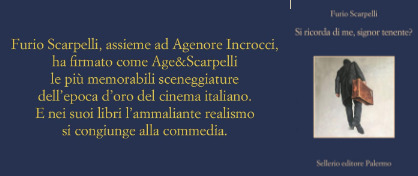
Furio Scarpelli e Agenore Incrocci hanno firmato, sotto la nota sigla di Age&Scarpelli, “le più memorabili sceneggiature dell’epoca d’oro del cinema italiano”, da Totò le Mokò di Bragaglia, a La banda degli onesti di Mastrocinque, C’eravamo tanto amati di Scola, I soliti ignoti, L’armata Brancaleone e La Grande guerra di Monicelli, per citarne solo una minima parte. Tra gli inediti di Scarpelli che Sellerio sta ripubblicando (è del 2019 Amori nel fragore della metropoli) vi consigliamo Si ricorda di me, signor tenente?, romanzo che introduce i protagonisti alternando, con la tecnica del flash back, la narrazione contemporanea al memoriale di guerra. Lo scavo nel complesso passato del personaggio principale porterà alla luce gravi traumi, profondi e rimossi sensi di colpa. Ma chi è lo sgangherato seccatore che apostrofa con la domanda del titolo il vecchio Giulio, tranquillo pensionato che passeggia per le vie della Milano del 1999? Un truffatore, un commilitone o un rigurgito della sua coscienza addormentata? Si legge piacevolmente tutto d’un fiato.
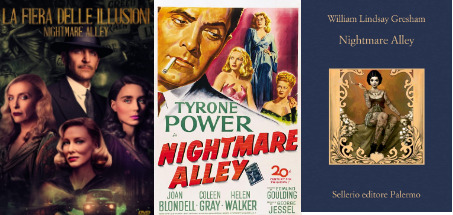
Per una lettura diversa dal solito vi proponiamo Nightmare Alley, La fiera delle illusioni di William Lindsay Gresham, “una tipica storia noir”, da cui sono stati tratti ben due film: un classico con il fascinoso Tyrone Power in una veste per lui inedita e il recentissimo remake di Guillermo Del Toro con Bradley Cooper, Cate Blanchett, Willem Dafoe. Diviso in due parti (con un finale ad anello): da un lato il fantastico, bizzarro, grottesco mondo del circo, con i suoi misteri e le sue crudeltà; dall’altra quello dell’alta borghesia, non meno pericoloso. In sintesi, il libro e i due film sono “Tre facce della stessa storia che presentano tutte letture degne di essere lette e viste per una storia che potrebbe benissimo svolgersi anche al giorno d’oggi. I prestigiatori, che siano o meno appassionati di mentalismo/spiritismo, vi troveranno molti spunti interessanti.”
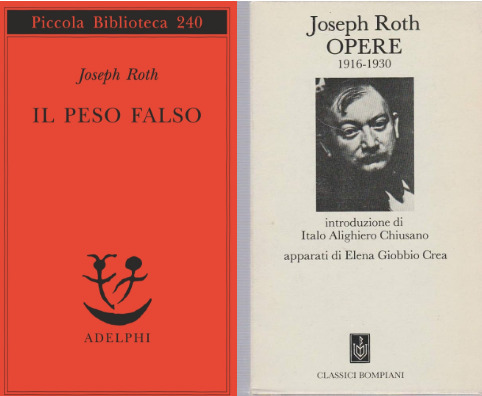
Un prezioso suggerimento dal passato: se vi fosse sfuggito, potete rimediare cogliendo dai nostri scaffali Il peso falso di Joseph Roth. Un autentico gioiello che mischia allo stile formulare dei poemi omerici, un’autentica passione d’amore e una finissima riflessione sull’essere umano, dominato dai suoi difetti, quasi deterministicamente volto verso il male, incapace di sfuggire alla tentazione del peccato, anche quando è mosso dalle migliori intenzioni. I temi sono quelli consueti della poetica di Roth, e spesso tornano anche gli stessi personaggi, che inevitabilmente cadono nella colpa: il tutto senza pessimismo né amarezza, anzi forse con una leggera sfumatura di fatalistica ironia.
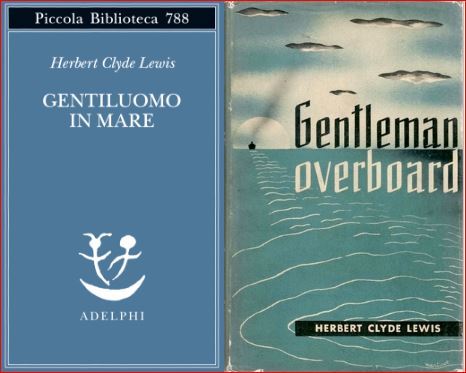
Come una diabolica matrioska le vicende biografiche dell’autore, Herbert Clyde Lewis, giornalista e scrittore americano, nato a New York da ebrei russi emigrati, si ripercuotono sul protagonista del romanzo per poi accanirsi inspiegabilmente sulle vicissitudini editoriali dell’opera che vi vogliamo consigliare, Gentiluomo in mare. Sì, perché come l’autore ebbe una vita difficile, nonostante gli incessanti sforzi profusi per affermarsi e l’indubbio talento, così il protagonista di questo delizioso romanzo breve è vittima di “una sorte bizzarra e cattiva”, per citare la splendida canzone di Lauzi-Conte, e infine la novella fu ingiustamente ignorata alla sua prima pubblicazione nel 1937 per essere poi “ripescata” (è proprio il caso di dirlo) dall’abisso dei libri dimenticati per la prima volta in Argentina nel 2010: da quel momento il successo, più che meritato anche se postumo, divenne planetario. Davvero “una perlita”, come fu definito nella recensione argentina.
#gabriel garcia marquez#arto paasilinna#carlo lucarelli#georges simenon#furio scarpelli#agenore incrocci#william lindsay gresham#joseph roth
14 notes
·
View notes
Text
La norma sull'utilizzo delle fonti rinnovabili stabilisce standard non raggiungibili, creando solo frustrazione, mancanza di credibilità e costi elevati. Ecco perché sarebbe meglio un approccio più pragmatico e meno ideologico
Azzeccare previsioni è relativamente semplice, purché non riguardino il futuro. Questa volta però una previsione la facciamo: non vi è alcuna possibilità che gli obiettivi fissati nell’aggiornamento della Direttiva europea (RED III) per quanto riguarda le fonti rinnovabili possano essere raggiunti. Almeno in Italia, ma gli altri stati europei non stanno meglio. L’obiettivo fissato è che al 2030 siano rinnovabili il 42,5% dei consumi finali di energia più un obiettivo non vincolante (ma che significa?) del 45%. Attenzione, questo obiettivo non riguarda la sola energia elettrica, se fosse così già quasi ci saremmo, ma il 42,5 di tutta l’energia. Quindi dobbiamo nello stesso tempo aumentare la quota di energia elettrica prodotta con le rinnovabili e aumentare la quota di elettricità sul totale di energia consumata. E la differenza è enorme. L’elettricità infatti è oggi solo il 21,5 per cento del totale dell’energia consumata.
Per capire di che cosa stiamo parlando è meglio cominciare dai consuntivi, che al contrario delle previsioni presentano numeri certi. Nel 2022, secondo i dati del MASE, solo il 19% dei nostri consumi finali erano da rinnovabili. Sole, vento, idro, geo, ma anche rinnovabili termiche, compresa la legna da ardere, e un po’ di biometano. Nel 2014 era al 17,1. In 8 anni siamo quindi cresciuti di 2 punti. Nei prossimi 7 dovremmo crescere di 23, 5 punti, 12 volte in più del tasso di crescita registrato fin qui. Anche se facessimo oggi tutta l’elettricità con le rinnovabili, cosa impossibile, ci fermeremmo al 31,8, più di 10 punti sotto l’obiettivo. In Europa le cose vanno appena meglio. Siamo al 21% medio, appena due punti sopra l’Italia, grazie soprattutto ad alcuni paesi del Nord Europa, come Svezia e Finlandia, ricchi di idroelettrico e legname.
Da noi la discussione è tutta centrata sulle rinnovabili elettriche, ma occorre capire che in realtà si tratta di perseguire, come detto, un doppio obiettivo. Non solo aumentare la produzione da rinnovabili, ma contemporaneamente aumentare di molto la quota di consumi energetici soddisfatti dall’elettricità. Dal 21,5 % di oggi al 29% nel 2030. Sembrano pochi 8 punti. Ma il combinato disposto fra le due cose, più rinnovabili e più elettricità nei consumi finali in un tempo così breve, comporta obiettivi irrealizzabili. Stessa cosa per le altre rinnovabili termiche.
Diversi studi, TERNA, Confindustria, Università di Padova, hanno fatto i conti e indicato cosa occorrerebbe fare. Bisognerebbe da oggi al 2030 installare 700.000 pompe di calore all’anno. Immatricolare 1 milione di auto elettriche all’anno. Nel 2022 sono state 50.000. Installare 120 GW di nuove rinnovabili al ritmo di quasi 20 all’anno contro i 3 dell’anno scorso e almeno 120 GWh di sistemi d accumulo. Aumentare di 15 volte la produzione di biometano. Naturalmente il mix può cambiare, ma siccome nessuno di questi obiettivi singolarmente ha serie possibilità di essere raggiunto le cose non cambiano. Non credo ci sia un solo esperto di problemi energetici che possa ritenere questi obbiettivi realizzabili. Rimane da capire perché l’Europa si ostini ad alzare l’asticella di obiettivi chiaramente non raggiungibili, creando solo frustrazione, mancanza di credibilità e costi elevati. E perché l’Italia che pure ha fatto molti compiti a casa non faccia presente che forse un po’ di realismo servirebbe. Negli stessi giorni dell’approvazione della Direttiva la Presidenza spagnola ha predisposto un documento dai toni più che allarmistici sulla carenza di una serie di materiali necessari per soddisfare tutte le esigenze. Con il rischio che i costi vadano alle stelle e la dipendenza dalla Cina, dice il documento, raggiunga lo stesso livello di quella precedente dalla Russia. Suona quindi surreale il commento del relatore tedesco Markus Pieper del Ppe secondo il quale “questa direttiva dimostra che Bruxelles può essere poco burocratica e molto pragmatica”. Il punto è che la Ue si è incastrata da sola ponendosi un obiettivo, quello delle zero emissioni al 2050, che la costringe a stabilire tappe intermedie altrettanto velleitarie. L’unico risultato per il momento è la perdita di competitività dell’industria europea, la creazione di mercati, auto elettriche e rinnovabili, per i produttori cinesi, l’aumento dei costi per imprese e famiglie. Nel frattempo il contributo delle emissioni europee al totale mondiale continua a scendere. Soprattutto perché crescono quelle degli altri.
34 notes
·
View notes
Note
muistaaks jättis jäätelön ja varsinki siin punases mansikka maus? yritin ettii mut ei varmaa enää myydä
Jättislempparini ovat olleet vanilja, lakritsi, kaktus (2013) ja sour (2014). Vanhat hyvät jättikset ovat ilmeisesti poistuneet myynnistä 😔.
Marraskuussa 2024 makuina ovat: kinuski, vanilja, bestis classic, bestis suolainen kinuski, bestis salmiakki ja kuningatar. Lisäksi minituutteja on saataville 6 tuutin pakkauksissa mauissa bestis classic ja bestis salmiakki. Bestiksen ero tavalliseen jättikseen on että se sisältää ilmeisesti jotakin rouskuvaa, kuten muroja.
"6. huhtikuuta 1979 tuotantoon otettu vanilja-Jättis oli Suomen ensimmäinen jättituutti. Nummelan maatalousmessuvieraat olivat ensimmäisiä, jotka pääsivät maistelemaan suurta jäätelöuutuutta, ja kaikki jäätelöt myytiin messuilla päivässä loppuun. Iso tuutti ja pursotettu muoto toivat jotain täysin uutta pienempiin ja tasaisiin tuutteihin tottuneille suomalaisille. Tuolloin Jättis-tuutit pakattiin vielä muovipusseihin ja teipattiin kiinni. Moni asia on muuttunut tästä, mutta jäätelöä valmistetaan edelleen Suomessa suomalaiseen makuun.
Jättis-makuja on vuosien varrella karttunut moneen lähtöön, mm. toffee, appelsiini, lakritsi, päärynä, vadelma, minttu-suklaa, salmiakki, kinuski, sitruuna-lakritsi, nougat ja kaktus. Kaikki maut on kehitetty erityisesti suomalaisten makumieltymysten mukaisesti kuten esimerkiksi Salmiakki-Jättis, jolle myönnettiin Suomen Salmiakkiyhdistys ry:n Salmiakki Finlandia -palkinto vuonna 2006."
Teksti täältä.
youtube
Yllä olevan mainoksen ajankohta tuntematon.
youtube
Yllä oleva mainos: 2022.
youtube
Yllä olevassa videossa testataan Jättis Vanhanajan mansikkaa. Video vuodelta 2013.
3 notes
·
View notes
Text
This is the first time since the start of her senior career that Rion Sumiyoshi finished off the podium at a GP event
Grand Prix de France 2022 - 🥉
NHK Trophy 2022 - 🥉
Grand Prix de France 2023 - 🥉
Finlandia Trophy - 🥈
Grand Prix de France 2024 - 🥉
4 notes
·
View notes
Text
Since Yuzu gave the green light to talk about members-only videos (with spoilers, but no reposting of parts/full video), I want to share some thoughts about pro Notre-Dame de Paris.
Firstly, NDP was a program that Yuzu himself said to not have fully understood back in 2012-13, so he was basically doing the choreo and trying to express emotions that he couldn't quite grasp. Finally, at FaOI 2022, as a mature young man, understanding the emotions from NDP, he expressed them very beautifully in his encore at the last show in Shizuoka.
Back in 2022 we could all see how much he had improved since 2012-13, side by side: his speed across the ice, the speed of his spins, the emotions so clearly conveyed through body language and facial expression... it was a rollercoaster and a goddamn good one. I hoped that we'd see at some point the full 27yo NDP version. That did not happen. BUT 28yo Yuzu did it.
It's true, in the manner Yuzu films himself, the facial expressions aren't clear at all except in a couple of moments, but his body language speaks very loudly. What can be appreciated to the fullest is his skating. Just like at FaOI 2022, his speed was incredible, both across the ice and in spins. But what really got to me... is how simple the choreography looks now.
Pro athelete Yuzuru Hanyu skates Notre-Dame de Paris like it's child's play while 17yo Yuzu, at Finlandia Trophy 2012 (the best NDP performance until two days ago), was so exhausted that he sprawled belly down on the ice right after the music ended. This time, he ended the program with a perfect T-stop right in front of a camera set down on the ice.
Several highlights of the YT video for me are: the 4S, the step sequence, 3Lz+2T+2T, and the choreo sequence. Everything just looked so effortless and I missed Yuzu's Lutz so much and to see it done in a very easy combination (for him) as well as on its own, it was so gratifying.
45 notes
·
View notes
Text
Guang-hong de la Iglesia Wins First Grand Prix Final
Altin’s second loss of the season
December 10, 2023
SHANGHAI, CHINA – Guang-hong de la Iglesia of China became the first Chinese man to win the Grand Prix Final, defeating three-time World Champion Otabek Altin of Kazakhstan, and delivering him his second loss of the season. The 24-year-old is coming off an undefeated season so far, winning his season opener at the Finlandia Trophy and both Grand Prix events – Skate Canada and the Cup of China. “I can’t even think straight right now,” said the three-time World medalist. “I’ve been working so hard, and I knew I could win here, but to actually do it feels incredible.” He was third after the short with 105.47 and won the free with a score of 214.24 for an overall score of 319.71
Otabek Altin of Kazakhstan had his second second-place finish in a row. He won his season opener at the Nepela Memorial and won Skate America. However, he lost the Grand Prix of Espoo to Jean-Jacques Leroy, his first loss since the 2022 Olympics. “While, yes, it is a second loss, and of course, I wanted to win, I said at Worlds last season that it would be difficult,” said the 26-year-old. “I’m happy with how I did, and I look forward to the rest of the season.” Altin and de la Iglesia will meet two more times this season, at Four Continents and Worlds. He scored 107.91 for the short, 209.96 for the free and 317.64 overall.
Winning bronze was 2022 World Champion Seung-gil Lee of South Korea, his second straight at this event. Fourth after the short program with a score of 104.25, he was third in the free with a score of 207.07 and ended up with an overall score of 311.32. “I did well today. I have improvements to make,” said the 27-year-old. “My plan is to be on the podium again at Worlds, and I am working well towards that goal.” Lee was second at Skate America and won the Grand Prix de France.
#blog canon#fake news articles#gpf23rp#getting caught up#had to skip a lot of articles but I just can't do them all#just search on the blog if you're curious#results are all there
3 notes
·
View notes
Text
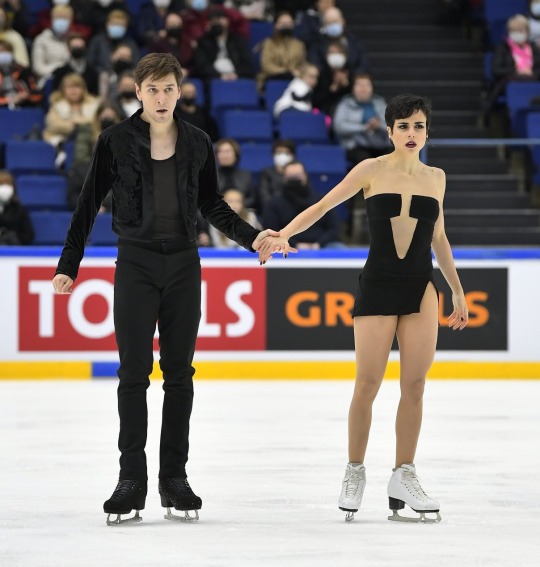

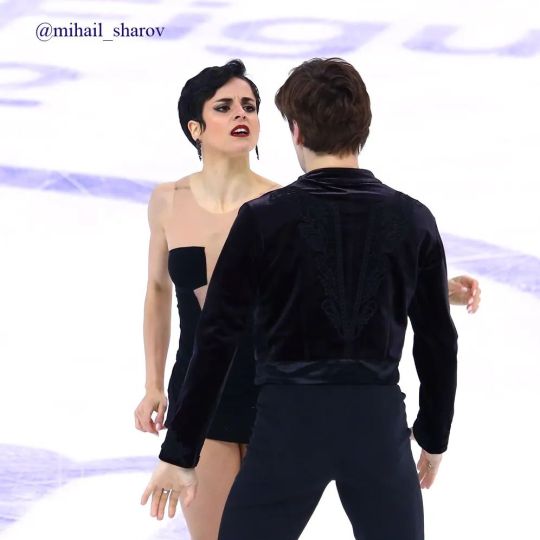

Sara Hurtado and Kirill Khaliavin's free dance costumes at the 2021 Finlandia Trophy and 2021 Rostelecom Cup. They skated to Since I've Been Loving You and Stairway to Heaven by Led Zeppelin.
(Sources: 1, 2, 3 and 4)
#Sara Hurtado#Kirill Khaliavin#Hurtado Khaliavin#Ice dance#Figure skating#Spain#2021–2022#2021 Finlandia Trophy#2021 Rostelecom Cup#Led Zeppelin
23 notes
·
View notes
Note
So can you please explain your me what is going on with Sara Hurtado and IAM, or Olivia Smart, or is it MF? Talk to me please.
i can't lol i don't know that there's anything going on there related to the current situation, either 🤷🏻♀️😅
but i was looking at how the one Olympic spot for Spanish ice dance was decided for Beijing 2022, and it was total scores!! 💀
Olivia/Adrian went head to head against Sara/Kirill at Finlandia, Spanish Nationals and Europeans in 2021/22 to decide who got to go to the Olympics, and it was not TES only, it was the total score for the 3 events. so what happened between then and now, and who decided to change the criteria?
Val/Kazimof are a promising young team, but they're nearly as new as Olivia and Tim - they've been together since 2022. this rule change favors them for sure. if it was total scores, they would barely be in the conversation, let alone winning the spots
but Sara/Adrian were an OG Gadbois team from 2011 til they split in 2015 - they were the Spanish team that Patch was with in Sochi when he supported VM because Marina wasn't there for them
so i've always wondered why Adrian stayed with MFP and Sara left
i don't know why the Spanish Fed made the rules this way, if they knew they were tipping the scales for V/K and for Hurtado/Khaliavin's Spain-based school. but Olivia/Tim made mistakes, unfortunately 😢
3 notes
·
View notes
Text
RECORD DI RICICLO IN EUROPA: L’ITALIA SECONDA

Nell’ultimo anno l’11,8% dei materiali utilizzati nell’UE è stato originato da materiali riciclati, il livello più alto registrato da quando si è iniziato a raccogliere dati nel 2004.
Questo indicatore è noto come “tasso di utilizzo circolare dei materiali” o “tasso di circolarità” e misura il contributo dei materiali riciclati all’uso complessivo dei materiali. Rispetto all’anno precedente, il tasso di circolarità è aumentato di 0,3 punti percentuali, diventando la quota più alta finora registrata. I dati sul tasso di utilizzo dei materiali circolari rilevati da Eurostat presentano un tasso di circolarità del 2023 più elevato per i minerali metallici con il 24,7% (+2,2% rispetto al 2022), seguito dai minerali non metallici con il 13,6% (+0,3%), dalla biomassa con il 10,1% (+0,7%) e dai materiali/vettori di energia fossile con il 3,4% (+0,6%). I Paesi che hanno rilevato i risultati più virtuosi sono i Paesi Bassi (30,6%), seguiti da Italia (20,8%) e Malta (19,8%). I tassi più bassi sono stati registrati in Romania (1,3%), Irlanda (2,3%) e Finlandia (2,4%).
L’aumento del tasso di riciclo favorisce il minor consumo di materie prime e la riduzione di produzione di rifiuti, abbassando gli sprechi. L’economia circolare che ne deriva prevede di migliorare la capacità di condividere, noleggiare, riutilizzare, riparare, rinnovare e riciclare materiali e prodotti esistenti il più a lungo possibile per aumentarne la vita utile. Il piano d’azione per l’economia circolare del 2020 mira a raddoppiare il tasso di utilizzo circolare dei materiali nell’UE entro il 2030, raggiungendo il 23,2%.
___________________
Fonte: Eurostat: foto di Magda Ehlers

VERIFICATO ALLA FONTE Guarda il protocollo di Fact checking delle notizie di Mezzopieno
BUONE NOTIZIE CAMBIANO IL MONDO Firma la petizione per avere più informazione positiva in giornali e telegiornali

Se trovi utile il nostro lavoro e credi nel principio del giornalismo costruttivo non-profit | sostieni Mezzopieno
10 notes
·
View notes
Text
La otra cara de la moneda
Los países miembros de la Eurozona pueden acuñar hasta dos monedas conmemorativas o de celebración al año, siendo las de 2 euros las destinadas a esta causa, cuyas tiradas, limitadas, son de curso legal. Finlandia le dedicó una a Tove Jansson en 2014, Francia a Simone Veil en 2018, Italia a Maria Montessori en 2020 o la Ciudad del Vaticano a Madre Teresa de Calcuta en 2022. Este año Grecia dedicará una a Maria Callas por el centenario de su nacimiento e Italia a Raffaella Carrá coincidiendo con el segundo aniversario de su muerte. España bien podría dedicar una a, por ejemplo, Lola Flores, ya que comparte con la soprano de ascendencia griega la celebración del que sería su centésimo cumpleaños. Pero no. Nuestros referentes femeninos se reservan a una serie de coleccionista que emite la Fábrica Nacional de Moneda y Timbre con motivo del 8M.
Artículo de Elena González (@lacalandria) para eldiario.es / canariasahora. #Womenhistorymonth #numismática #monedasconmemorativas #monedasdecoleccionista #americanwomenquarters #referentesfemeninos
3 notes
·
View notes
Text
Entrevista para el Chicago Tribune y Los Angeles Times (Otoño 2022)
Metro Underground / Entender la noche del otro
Entrevista a Brontis Jodorowsky
Alfredo Padilla
En mi puericia, al contacto de mis primeros coqueteos con el cine, conocí a Brontis Jodorowsky, en una película del español Luis Alcoriza. Brontis interpretaba el papel del niño Daniel, una especie de ángel hermafrodita que vive con su madre (Fabiola Falcón), en una casona semidestruida de Bogotá, dentro de una atmósfera de claustrofobia sexual, incesto, fetichismo y voyerismo. La cinta llevaba por nombre El muro del silencio (1974), y había marcado profundamente mi niñez, irrumpiendo el sueño de mi razón; el personaje de Brontis era inocente aún en su malicia. Posteriormente lo vería en Bayoneta (2018), de Kyzza Terrazas, en el papel de Dennis, el antiguo entrenador de Miguel “Bayoneta” Galíndez (Luis Gerardo Méndez), un boxeador retirado, cuyo funesto destino lo llevaría a vivir en cierta buhardilla de un complejo habitacional en Turku, Finlandia. Ambos personajes, el ángel colmado de malicia y el coach de boxeo convertido a padre postizo, trazarían una línea narrativa en mi vida, que me llevaría a mi comprensión del Yo y al olvido de los recuerdos que no pude tener, porque como escribió el poeta Enrique Lihn: “no hay nada más difícil de olvidar que las intenciones que no llegaron al acto, los actos suspendidos en la sorpresa y la violencia”.“Hoy cumples siete años, ya eres un hombre. Entierra tu primer juguete y el retrato de tu madre”, le dice el protagonista (Alejandro Jodorowsky) a su hijo (Brontis), en la película El Topo (México, 1970), “¡Destrúyeme! No dependas de nadie”. Un brutal despojo de la infancia perdida, que me ayudaría a quemar las naves de un cruento pasado construido por otros. Hoy, dejando nuevas huellas en arenas que desconozco, me complace presentarles mi entrevista, con el laureado actor y director mexicano-francés, Brontis Jodorowsky, en la que hablamos sobre el reencuentro con la consciencia de la humanidad, la identidad, la noche oscura del alma, las crisis, su libro Algunos cuentos de sabiduría y otras tonterías: ficciones para faltos de tiempo (2017), de su papel en la película Bayoneta (2018) de Kyzza Terrazas y del concepto de la muerte.
A.P. : En Táu (2011), la película de Daniel Castro Zimbrón, interpretas a Gustavo, un hombre que viaja al desierto de Wirikuta, en una expedición que confrontará su más profundo dolor. Tras la pandemia, mucha gente lo perdió todo, o al menos, lo más vital. ¿Qué viaje debemos tomar para reencontrarnos con nosotros mismos?
B.J. : Hubieron una variedad de reacciones con la pandemia, tanto a nivel gubernamental como personal, de país en país sobrevinieron actitudes similares, y a la vez muy distintas. Lo que me pareció fundamental y que también tiene que ver con la crisis climática, es que fue un fenómeno que tocó a toda la humanidad. Claro, fue una oportunidad para un trabajo sobre sí mismo, por estar aislados, y mucha gente sintió que tenía que “rentabilizar“ el Covid-19 escribiendo sus memorias, realizando web meditation o tik tok yoga; todo esto tiene que ver con una forma de individualismo que promueva la sociedad. Asocio tu pregunta con la idea de la autoayuda ; el trabajo sobre sí mismo es necesario, sí. Pero la noción de autoayuda tal como se ha desarrollado, con todas sus publicaciones - que alimentan un mercado - tiene un poco que ver con el ombliguismo, el cada cual por su cuenta y esa ilusión del Self-made man, a la raíz de ciertos males de nuestra sociedad. La verdadera apuesta después de la crisis que hemos pasado es cómo reencontrarnos juntos, más que reencontrarse a sí mismo. No podemos hablar sobre lo que todo el mundo perdió dado que hay gente que no perdió nada (muchas empresas de Internet, los servicios de streaming, por ejemplo, bendicen la pandemia). Hay gente que sí perdió mucho, según su clase social y su nivel económico, los ahorros, la talla de su casa, etc. No es lo mismo si te separaste de tu pareja porque resultó difícil convivir 24 horas sobre 24, o si la pareja sobrevivió a ese test y se dieron cuenta de que su amor podía atravesarlo todo. Yo te puedo hablar de lo que yo sentí y de lo que más me dolió: esa separación con mis seres queridos, con mis hijas, la disgregación geográfica. En París, después del primer confinamiento podíamos pasear solo dentro de un área de un kilómetro alrededor de nuestro domicilio, y una de mis hijas vivía a un kilómetro 300. Trampeamos un poco. Entendí como nunca el valor del contacto humano, el valor de compartir momentos, el valor de un simple abrazo. Ciertos aspectos del modo de vida que propone la sociedad nos llevan a enfocarnos en nosotros mismos, las sobre presentes redes sociales nos acorralan con sus algoritmos que siempre te ofrecen lo que te gusta, lo que te mantiene dentro de tu territorio mental y emocional para que con esas pequeñas dosis de dopamina artificial puedas soportar una existencia absurda. Hay que encontrar los caminos para guardar la consciencia de que este fenómeno nos tocó en tanto que humanidad, y que ha durado — en China todavía están con políticas “Zero Covid“ de aislar ciudades enteras, mientras que otras ciudades quedaron abiertas en plena crisis por motivaciones político-económicas y lo pagó muchísima gente por falta de precaución; otras encontraron su equilibrio. Si alejándose de intereses egoístas — que en el fondo son intereses comerciales, la humanidad hubiese tratado el problema de manera global, habríamos hecho un progreso. Hoy en día estamos frente a un problema más grave aún: el de la urgencia climática. Estamos desordenando completamente el medio ambiente gracias al cual vivimos y en una actitud de inconsciencia suicidaría no estamos reaccionando en tanto a humanidad… Me parece que más que preguntarnos qué hacer para reencontrarnos con nosotros mismos, individualmente, deberíamos preguntarnos : ¿cómo hacemos todos para reencontrarnos dentro de la consciencia de la humanidad?
A.P. : Muchos de nosotros tenemos la sensación de que cuando queremos abandonar un espacio denominado como “nuestra identidad”, entramos en otro lleno de incertidumbre, donde nos sentimos a ciegas. La noche oscura del alma es para algunos místicos un periodo de tristeza, miedo y angustia necesario para acercarse a Dios. ¿Estamos pasando por esta etapa, o es simplemente ansiedad generalizada?
B.J. : La cuestión de la identidad es interesante, sobre todo actualmente. Necesitamos pertenecer, el ser humano es un ser social que se desarrolla en contacto con otros seres humanos, según los estímulos que recibe del exterior. Esto es puramente teórico, pero a un bebé recién nacido lo metes en un cuarto totalmente oscuro y en quince días se vuelve ciego, dado que la luz no ha estimulado su nervio óptico. Emocionalmente somos así: un ser no querido, no acariciado, tendrá más dificultades para vivir la empatía y la compasión; en la vida, si recibes amor lo puedes compartir. A la vez, la noción de identidad puede ser es algo que te encierra en modelos de pensar preestablecidos, en modelos de sentir, de actuar. Como todo ser, una sociedad es orgánica, tiene grandes riquezas y grandes trampas, aspectos terribles y otros luminosos. La identidad en su faz oscura, es algo que te va a encerrar, a limitar, que va impedirte el acceso a tu verdadero ser; es un sistema de inhibiciones. La religión, por ejemplo, es pertenencia, es formar parte de un grupo que se identifica con un mito, en principio con el objetivo de elevación espiritual compartida. Pero a la vez la iglesia está llena de prejuicios sobre la sexualidad, de sistemas de poder, de misoginia, etc. Es muy doble eso de la identidad. Hasta políticamente: puede ser una noción de cohesión social o un veneno absoluto. Hay una bonita adivinanza para niños, que a veces a los adultos les cuesta resolver: “¿Qué está más lejos de ti, la punta de tu nariz o el pulgar de tu pie?“ ¡La respuesta es ninguno de los dos, dado que los dos son tú! Cuando realizas que has vivido en pertenencia a una identidad impuesta, o a la cual no te identificas más, querer separarte de ella es delicado; no te vas a cortar un brazo, so pretexto de que de esa manera serás más tú… Hay que saber distanciarse sin perderse. Porque, en el fondo, nuestra identidad está ligada a nuestra vivencia, a nuestro transcurso; somos un relato. Y nuestra historia personal, familiar, social, está ligada — como las grandes obras de teatro de Shakespeare que combinan la pequeña y la grande Historia — con muchas circunstancias de la narrativa que compartimos con los demás, con la sociedad. Dentro de eso, hay que tener clarividencia. Me hablas de identidades, de saber quién eres. “¿Quién soy?“, es una pregunta compleja, a veces angustiante. Pero si “Quién soy“ es complejo, vaporoso, fluido, algo intangible; más accesible es saber quién NO eres y dejar caer lo que no eres, lo que sientes que no eres, lo que van a ser las inhibiciones, los prejuicios, los límites mentales, los miedos emocionales, etc. Eso lo puedes identificar, es palpable, concebible, desechable. Por otra parte, si estamos de acuerdo con Carl Jung, de que el inconsciente tiene una dimensión colectiva, entonces “Quién soy“ no puedes ser nada más tú, tu Yo. La pregunta se transforma entonces por ella misma en “Quiénes somos“. Volvemos a la identidad… Según el sicólogo francés Serge Tisseron una de las preguntas que causa ansiedad es la del sentido de la existencia: “Qué sentido tiene mi vida“ y él argumenta que es una pregunta imposible, a menos de darse cuenta de que, in fine, el sentido de nuestra vida es el sentido que tenemos para los otros. Vale la pena meditarlo. En el mito judeocristiano, Jesús dice: “Por sus obras los conoceréis”. Así como el conjunto te recibe, le da sentido a tu vida. Eso no quiere decir que si el conjunto te recibe bien, ese sea tu verdadero sentido: a veces tienes que ser alguien que rompe las barreras, que sale de los esquemas, del conformismo, que va más allá de lo previsto, que hace avanzar a la humanidad de un salto con un nuevo conocimiento o una inspiración artística; ahí puede haber una forma de rechazo hacia ti. ¿Quiere eso decir que tu vida pierde su sentido? No, puesto que tras un tiempo, lo que es justo permanece y el mundo progresa. El conjunto avanza más lentamente que el individuo. Ahí entramos en otro espacio lleno de incertidumbre: tenemos algo inscrito muy profundamente en nosotros, en lo que algunos llaman el cerebro reptiliano, que es la noción de territorio. Fuera del territorio conocido, está el peligro. Un tigre, por ejemplo, tiene un territorio: lo marca con su orina, en él tiene de qué beber, presas, sol y sombra, etc. Si sale de su territorio, se mete a la comarca de otro tigre, donde puede haber peligro, falta de agua o de presas, es decir peligro de muerte. Nosotros tenemos un territorio mental (me identifico a lo que pienso o a ideas aprendidas), un territorio emocional (me identifico a lo que siento o a mis temores), un territorio sexual (me identifico a lo que deseo o a mis prejuicios), territorios que pueden ser catastróficos, pero que corresponden a lo que conocemos. El conjunto de nuestros comportamientos repetitivos, de nuestra manera de pensar, de lo que hemos sentido, los deseos que hemos podido satisfacer o no, ese es nuestro territorio. Nos cuesta cambiar de rutina, abrirnos a nuevas ideas, abrir nuestro corazón a nuevos sentimientos o aceptar los sentimientos negativos que descubrimos nos habitan y que reprimimos a tal punto que nos ahogan. Tenemos temor al cambio y a lo desconocido porque nos introduce a un territorio oculto. Metafóricamente hablando, a menudo preferimos un aire viciado que conocemos a un aire puro desconocido. Sin embargo, en el momento en que te quieres conocer renunciando a lo que no eres, inevitablemente vas a entrar a un territorio ignorado hasta entonces. La única manera de ampliar tu conocimiento, es ir a lo desconocido y soltar lo que no eres; además de cuestionar tu sentimiento contigo mismo, ello cuestionará tu sentimiento para con los otros. Y viéndote a ti mismo de otra manera, ellos también te van a percibir de otra manera: te pueden rechazar o aceptar. En ese sentido es útil el trabajo con los sueños. En su libro La Maîtrise des Rêves, Marc-Alain Descamps explica que no te puedes morir en tus sueños, porque nuestra mente no conoce el estado de su no consciencia. Si sueñas que estás dentro de un ataúd y que la gente está llorando, hay un punto de vista tuyo, no estás desaparecido. Todos hemos tenido esas pesadillas en las cuales te persigue un monstruo para comerte. Tiene variadas formas, pero es un mismo esquema narrativo de algo que te va a devorar: expresión probable de una pulsión reprimida. Aunque pueda ser a veces el llamado de un proceso positivo, tú lo ves como un angustiante monstruo que va a devorar el ser limitado que eres en ese momento. Cuando trabajas el sueño lúcido, durante una tal pesadilla de persecución devoradora, puedes darte cuenta de que estás soñando. En ese momento, en vez de huir con angustia o esforzarte en despertar, te detienes, haces frente al monstruo, hasta corres hacia él. Ahí va a haber una gran luz y un despertar lleno de orgullo, un sentimiento de fuerza y plenitud que puede durar una semana. Te cuento algo que he vivido. Volviendo a nuestro tema, el miedo a renunciar a lo que NO somos para encontrar quienes somos, es obviamente un proceso en el que debemos aceptar el miedo del que tú hablas y ese miedo, todos lo vivimos. Lo menciono porque es bueno realizar que mucha gente vive lo mismo que tú. Dicen en México: “Mal de muchos, remedio de pendejos”. A menudo cierto es. A menudo también no: el mal de muchos no será un remedio, pero sí ayuda saber que eres parte de un mal general, compartido. Regreso a la idea inicial: no soy un individuo, sino que somos, y ahí está para mí una posible solución.
A.P. : Como expresa el filósofo español Eugenio Trías: “en esta vida hay que morir varias veces para después renacer. Y las crisis, aunque atemorizan, nos sirven para cancelar una época e inaugurar otra”. ¿Cuál fue la noche oscura del alma que te convirtió en Brontis Jodorowsky?
B.J. : Es que no soy Brontis Jodorowsky, una entidad fija. Uno cree que es todo el tiempo el mismo, pero no: crecemos, nos achicamos; nos crece el cabello, luego se nos cae; tu energía es inextinguible, luego surgen dolores en diferentes partes del cuerpo; pasas de la insaciable curiosidad a la rigidez mental o sigues aprendiendo nuevas cosas, tu manera de comunicarte con los demás es más amena… Físicamente, las células de nuestro organismo se regeneran en permanencia. Al hígado le toma de seis meses a un año renovarse completamente, pero hay partes que en un día ya no son (somos) las mismas. Vivir es un cambio, una regeneración constante. Cuando te identificas a una personalidad, en cierta manera te anquilosas, mientras que el universo mismo está en perpetuo movimiento. En el microorganismo sucede lo mismo, estamos todo el tiempo adaptándonos a este proceso de la vida, ese proceso que es no morir. Como escribí en un aforismo: “Gracias a mis padres, que con la vida me han dado la muerte”. Vivir es en permanencia adaptarse a todo nivel al medio ambiente y a sus cambios. Entonces, ¿cómo imaginar que eres tú algo ya hecho e inmutable? Eso dicho, cuando yo era niño, mis padres hablaban mucho del cambio. Por una razón u otra había que "cambiar". El lenguaje es muy importante; el decirle a una persona « ¡cambia! » o « ¡tienes que cambiar! » me parece un enfoque erróneo. Un árbol no cambia, un árbol se desarrolla. No tengo por qué cambiar, si eso significa ser otra cosa que lo que soy. Cuando una familia te insta a cambiar, es probable que lo que quiere decir es « adáptate a mí », « sé como yo quiero que seas ». Un ejemplo : un árbol crece en un terreno ventoso y ese fuerte viento que sopla contra su tronco hace que crezca inclinado. Digamos que eres ese árbol. De repente te das cuenta de que ese viento te hace crecer chueco, adolorido y por un trabajo de concientización logras deshacerte de la influencia de esa toxicidad. Ahora, no porque cesa ese viento el árbol repentinamente se endereza como con resorte, "cambia" y adquiere a una forma ideal que se supone hubiera de haber tenido. No: tras la toma de consciencia y a partir de esa adquirida inclinación, empieza a crecer hacia la vertical. Pero lo negativo que padeció, es parte de su existencia, de sus ser y su desarrollo, es parte de su historia: somos una historia y todas las circunstancias terribles o maravillosas que vivimos forman parte de nuestro ser, nuestro ser que es relato. Yo no sé que es exactamente "la noche oscura del alma ». Sí sé que uno pasa en su historia por momentos de oscuridad, de dificultad, en los cuales te cuestionas si tienes la fuerza, el anhelo, la valentía suficientes para cuestionarte. Si lo pienso, la noche oscura del alma no es precisamente algo negativo: es un momento en el que el enfoque cambia y puedes ir hacia la comprehensión de lo que te sucede. Como todos, en mi vida he pasado por momentos de sufrimiento. El sufrimiento es parte de nuestra vida, no hay vida sin sufrimiento. La concepción que tenemos del sufrimiento tiene que ver con el dolor, concretamente. Desde los inicios del siglo XX y el descubrimiento de los analgésicos, nuestra civilización se ha vuelto férreamente anti-dolor: nadie tiene que sufrir de lo que sea y mucho menos de dolor físico. Los pain killers son muy recientes. Antes, con todas sus catástrofes y sus guerras — también con toda la maravilla de su desarrollo— la humanidad siempre había interactuado con el dolor: la gente vivía con dolor de dientes, con dolor de estómago, con dolor de cabeza, no era un escándalo, no tragaban una píldora a la menor incomodidad: atravesaban el dolor, por necesidad aprendían de él a vivir, con él. Hoy hay gente que llora porque la simple opinión que el otro expresa "le duele" y la vida en sociedad se vuelve imposible. No estoy en contra del tratamiento del dolor, obviamente, es un progreso importante de la medicina. Pero interrogo nuestra relación a este. Hay momentos en que puede también ser un maestro, una manera de comunicar de nuestro cuerpo con nosotros. ¿Cuándo te das cuenta que tu cuerpo existe? Cuando te duele; si no, lo olvidas. Somos muy mal agradecidos con nuestro cuerpo. De vez en cuando, cuando estoy procrastinando, me acaricio la mano, me acaricio el pie, los hombros, y le digo: “Gracias cuerpo, vas cargando mi consciencia todos estos años de mutación, fiel hasta que un día nos apaguemos; gracias, gracias, gracias.” Recomiendo hacerlo vez en cuando. Es de notar que al mismo tiempo que aparecieron los analgésicos, llegaron los estimulantes, los speed, la anfetamina, las drogas como la cocaína o la heroína, que te engancha porque durante el trip te quita el dolor, físico y psicológico. El alcohol seduce porque desinhibe, salen todas las pulsiones que la sociedad te reprime a veces sin razón, a veces con razón — no queremos que cunda por ahí la pulsión asesina… Esos momentos de la noche oscura del alma, como tú los llamas, son momentos necesarios que nos permiten una mirada introspectiva, a condición de que en esa oscuridad abramos los ojos. Se dice que muchos chamanes son voluntariamente ciegos; por alguna razón será. ¿Para entrar en una oscuridad (de la noche oscura del alma), a partir de la cual se ve mejor? ¿Y a partir de su mirada interior, poder entender mejor la noche del otro? De nuevo la relación con el otro… Cuando alguien fallece se reúne la gente en el velorio, y en general concluye el día de tristeza con una gran cena, en la que se es muy alegre y se come bien, porque la vida continua. La luz y la oscuridad están ligadas mitológicamente en las primeras frases de nuestro relato judeocristiano: lo primero que hace Dios en el cuento de hadas, es separar la luz de las tinieblas, el día de la noche. Es decir que en el origen van juntas, son una y misma cosa. ¿Cómo es eso que la luz y la oscuridad eran una y misma cosa? El mito nos hace aparecer después de que esa separación haya ocurrido, así que no nos es posible concebirlo: no lo "vimos". Pero es como el símbolo de Yin y el Yang: dentro de la coma negra hay un punto blanco, lo que implica que no existe la total oscuridad, como tampoco existe la total luz, dado el punto negro en la coma blanca. La total oscuridad y la total luz, como toda noción de pureza, son nociones en algo totalitarias. La pureza de la raza, por ejemplo, que blanden movimientos de extrema derecha, pureza basada en el rechazo del otro. La verdadera pureza, no es pura en ese sentido: la verdadera luz, nuestra luz mitológica, es día y noche oscura del alma a la vez.
A.P. : Me parece que tu libro “Algunos cuentos de sabiduría y otras tonterías: (Ficciones para faltos de tiempo)”, logra un portentoso ejercicio de prestidigitación literaria, al hacer que las historias cotidianas e íntimas, hechas de detalles, que en otras manos podrían resultar anodinos, se transformen en una poderosa narración de validez universal capaz de curar.
B.J. : Gracias, aunque no haya sido mi objetivo curar a nadie mientras lo escribía; no pretendo ser terapeuta. No me atraen las bonitas frases de sabiduría genérica (a menudo acompañadas de ilustraciones cursis), que plagan las redes sociales en búsqueda de « likes » y seguidores. Trato que todo lo que escribo tenga que ver con un proceso personal; mis micro-cuentos están, de una manera u otra todas ligadas con fantasías y procesos míos. Su breve formato es porque encuentro que hay algo de poético en el aforismo y porque ambicionaba ofrecer un libro que se pudiera leer “entre dos puertas“ o en los transportes públicos, por ejemplo. La multiplicación actual de solicitaciones a nuestra atención roen nuestro tiempo. Así que traté de reducir mis historias al mínimo de palabras, de hacer un proceso de destilación, o digamos de liofilización de mi experiencia, para que al contacto de la imaginación del lector las compactas historias se desarrollen en su mente, que este les dé contexto, marco e interpretación. Si, como dices, esa experiencia metafóricamente compartida le es útil al lector, me alegro; pero con que le arranque una sonrisa ya estaré satisfecho.
A.P. : En Bayoneta (2018), la película de Kyzza Terrazas, interpretas a Denis, el antiguo entrenador del boxeador Miguel “Bayoneta” Galíndez, quien vive exiliado en Finlandia - tras sufrir un fuerte trauma - trabajando de día como sparring en un gimnasio de boxeo, sin más esperanzas que ganar lo suficiente para alcoholizarse. ¿Qué te atrajo de esta historia, de tu personaje y qué te quedaste de él?
B.J. : Me atrajo el papel del coach y su relación con ese joven ex-campeón lidiando con la depresión y la culpa, un rol de humanidad, en un esquema que lejanamente me recordaba a John Wayne en el famoso Western Río bravo (1959). Las buena películas de género son a menudo un pretexto para hablar de otra cosa que lo que implican los cánones del genero mismo: en la película de Howard Hawks, más que de disparos, asaltos de banco o del Grand Canyon, se trata de la historia de alguien que intenta sacar a su amigo del alcoholismo, Wayne tratando de levantar a Dean Martin, una bella película sobre la amistad. En la parte coach/boxeador - Denis/Bayoneta, sentí que podía haber algo así. Ya al ver la película terminada, llegué a la aceptación final y total de que una cinta realmente encuentra su identidad en la mesa de edición. En tanto que actor, conoces el guión original, sabes las escenas que se filmaron, en qué orden estaban y luego ves la película y lo primero que sientes es que “faltan“ muchas de esas cosas. Claro Bayoneta es la historia de Galíndez, Luis Gerardo Mendez estaba en todas las secuencias, era su historia y lo esencial no era la relación con el coach. Pero en el corte final, de lo que había entre esos dos hombres quedó algo un poco esquemático. Había también otros personajes secundarios y otras sub-intrigas con actores finlandeses de mucho talento y también todo eso se cortó. Me encantan las películas que cuentan una historia principal enriquecida con "sub-historias", con personajes secundarios desarrollados, porque la vida está llena de cosas entretejidas, de micro-eventos y relaciones que no son lo esencial pero que le dan sabor y relieve a la narrativa. Luego, cada director hace la película que quiere hacer, la que le habla a él; es su visión la que cuenta, son sus años de arduo esfuerzo para que exista el film. Cuando lo platiqué con Kyzza, me dijo que había optado por un “estudio de carácter”. En general, como público, me interesan más las historias que los estudios de carácter; cuál sea la forma artística, anhelo en una obra la posibilidad de catarsis. Pero lo que cuenta es que un director sea fiel a sí mismo y aunque no fue un súper éxito taquillero, a mucha gente le gustó la película y yo me encuentro bien en las escenas que quedaron. Bueno, perdón: opinar sobre el trabajo de los demás es tan fácil…« opinadores » no faltan: todos tenemos opiniones que tomamos muy en serio. Afrontar el proceso creativo, lograr hacer una película, encontrar su vía personal, es otra cosa y le estoy agradecido a Kyzza por su confianza. A.P : Al final, “Bayoneta” Galíndez ve morir a un alce. ¿Cuál es su relación con su historia, es quizá la aniquilación del pasado?
B.J. : No sé. Esa es una pregunta para Kyzza, no para mí. Yo no actúo de ese alce, entonces no te puedo decir, jajaj. La metáfora del venado existe también en la película que hice con Daniel Castro Zimbrón, su opera prima Tau (2012), pero cobraba otro sentido dado que el contexto era Wirikuta, el desierto mágico, algo que ver con el duelo y con los huicholes…La breve aparición del venado azul es ahí algo bastante bonito. Hay un cineasta que ha tenido mucha influencia en toda una generación: Carlos Reygadas, y desde su reconocimiento internacional han aparecido en otras películas mexicanas elementos de ese tipo, que introducen algo « extraño », metafórico, fantástico, aunque no siempre de manera tan oportuna. A lo que voy es que un cineasta tiene que encontrar su cine, porque en cierta manera todas las historias ya fueron contadas; lo importante es cómo la vas a narrar tú: que seas pintor, escritor, cineasta, dramaturgo, lo que debes buscar es tu forma. Todos nosotros en tanto que seres humanos, en nuestra constitución neurológica, fisiológica, somos iguales; pero a la vez somos todos únicos: no hay dos huellas digitales, dos formas de orejas idénticas en toda la humanidad, no hay un diseño del iris igual a otro - por eso puede existir el reconocimiento facial. Carlos Reygadas encontró su cine, puede gustar o puede no gustar - a mí, por ejemplo, Nuestro tiempo (2018) me encantó: ahí llegó a su forma más completa y tengo mucho apetito por su próxima entrega. Pero ver aquí y allá « reygaderías », elementos sobrenaturales gratuitos o súper lentitud con no actores - por ese temor de ciertos directores de confrontarse a un actor y ese a priori que algunos tienen de que un actor no va a ser auténtico - pues no me interesa tanto. Ahora, cuando un cineasta abre puertas, también se puede explorar ese nuevo campo: en la muy buena Sundown (2021), Michel Franco introduce de repente un elemento así, con unos puercos en una ducha y es formidablemente coherente. Cuando es justo, es justo; cuando no, son efectos estilísticos vacíos.
A.P. : ¿Cómo se afronta con solemnidad la muerte de un ser querido?
B.J. : Lo sabes, mi hermano Cristóbal falleció el pasado mes de septiembre. ¡Qué tristeza! Más que afrontar, diría que la muerte se atraviesa, te atraviesa y transforma tanto a ti como al fallecido en ti. Tu amor por él, sin disminuir, cambia de naturaleza. Es ese el proceso del luto, por eso el tiempo que requiere: aceptación de la ausencia tangible, mutación de la presencia y del sentimiento. “Para que algo quede de ti en mí, debo dejarte ir… “ En fin, no se pueden definir procesos o recetas para todos los seres humanos y para todas las vivencias, todas las muertes. Lo vivo así ahora porque está relacionado con mi historia, mi transcurso. Ya he pasado por varias muertes. La primera, la viví a los 17 años, cuando falleció Renée, mi abuela materna. De familia muy católica, fue madre de 14 hijos, así que puedes imaginar además el numero de nietos y bis-nietos. Tenía más de 80 años, estaba agonizando en la clínica y había literalmente una cola para verla una última vez, con 15 minutos cada cual para despedirse de ella. A mis seis años mi madre se fue a hacer teatro a Polonia y me dejó medio año con mis abuelos. Me querían mucho y aún más quizás porque, dentro de la visión del mundo de esa familia tan tradicional, yo era “el pobrecito”: hijo ilegitimo (mi padre y mi madre eran amantes, él estaba casado), de un padre artista, ¡y judío además de todo!, abandonado en cierta manera ahí por sus genitores… Entonces me arroparon muy bien, con mucho afecto. Fueron probablemente mi primer modelo de pareja estable y amorosa. Recuerdo aún la cálida y tierna mano de Julien, mi abuelo medio ciego, durante los paseos por la tarde, y el delicioso aroma del entre-senos de mi abuela cuando me abrasaba cariñosamente en cualquier momento del día. Al llegar mi cuarto de hora para despedirme de ella, ya estaba a punto de irse – falleció al día siguiente. Me senté a su lado, le di la mano y pasamos los quince minutos mirándonos en silencio. Hay momentos así, en los cuales las palabras están de sobra. Transcurridos mis quince minutos, justo cuando nuestras manos aceptaban soltarse, pronunció suavemente, casi en un suspiro: “Je prendrai soin de toi” (Te cuidaré). ¡Qué gran regalo me hizo ahí! A pesar de que yo considere fundamental haber leído por lo menos el Génesis y los cuatro Evangelios, saber de mitología greco-romana, del sufismo o del pensamiento budista, no soy creyente. Pero ella sí creía. Había nacido católica, ido a Misa todos los domingos, vivido en la fe cada día y en ella moría, totalmente convencida de que al expirar iba a subir al Cielo y entrar en la luz de la Virgen María. Cuando pequeñas, mis hijas me preguntaron si Santa Claus existía. Como nunca quise mentirles, les dije: “Mientras crean en él, existirá”. Para ellas existiría y es lo que contaba para ellas. Reconozco y respeto el total y absoluto derecho de creer en Santa Claus, lo respeto profundamente (lo que obviamente no le otorga el derecho a nadie de obligarme a creer en Santa Claus, ni a imponer en mi casa a fines de diciembre un árbol podado con bolitas de colores - si captas la metáfora). Pero aunque yo no sea creyente, su intención amorosa de decirme que para siempre estaría conmigo, me apoyaría, me cuidaría desde ese cielo al que ella iba a naturalmente acceder, era un mensaje de amor profundo: “Te amaré más allá de la muerte”. Sus palabras se grabaron en mi corazón y han sido desde entonces una fuente de fuerza interior. Unos años más tarde, falleció Bernadette, mi madre, en un accidente de avión, y lo alucinante es que la tarde misma de su vuelo me dijo al despedirnos: “Si muero durante mi viaje, no quiero flores en mi entierro, porque son muy caras y mis amigos son muy pobres”. ¿Qué presciencia fue esa? La misma noche se estrelló su avión en las afueras de Madrid. Al principio no sentí nada. No vertí ni una lágrima, me quedé impávido cuando frente al Château de Vincennes su amigo Michel me anunció con voz temblorosa el accidente. No lograba entender: “Mi madre ha muerto. ¿Cómo es posible que no sienta nada — me dije. ¿Acaso soy un insensible, un ser sin corazón?“. Era simplemente que cuando un shock es tan fuerte, en un reflejo de supervivencia psicológica tu mente se protege del dolor. La mañana siguiente viajé a Madrid y al aterrizar empezó el proceso: vertí las lágrimas contenidas y entré en un extraño estado de lucidez dolorosa, en el que todo se volvió relativo; lucidez tan exigente y pura, que no se puede asumir más allá de un cierto tiempo. Deberíamos vivir en permanencia con la consciencia de la muerte, de nuestra posible muerte en cualquier momento, de la posible muerte en cualquier momento de nuestros seres queridos y, más allá, de la del entorno, hasta de la de la humanidad entera. Nuestra vida, el simple hecho de vivir, la vida misma adquiriría otra dimensión, otra calidad. Lo sabemos, en teoría. Pero ello requeriría un cierto grado de energía, de compromiso, me atrevo a decir de amor - y todos somos hasta cierto punto perezosos con eso, ¿no? Preferimos cerrar los ojos y seguir adelante, tibios, como si fuéramos eternos. Pero volvamos al momento. Con la mejor intención del mundo mi padre me aconsejó de no ver al cuerpo de mi madre. Temía que fuera para mí algo insoportable y traumático. Lo escuché, pero resultó ser un error: como no la vi (una tía monja que fue conmigo es quien asumió reconocer el cuerpo), mi mente no pudo integrar correctamente su fallecimiento. Por algo se dice “ver para creer“. Por no haberlo constatado con mis ojos, algo en mí se negaba a creerlo; hasta tuve un mes más tarde la alucinación de verla pasar en un automóvil frente a mi casa… Aprendí ahí lo fundamental que es el velorio, esa costumbre de pasar un tiempo con el cuerpo del fallecido. Un tiempo que te pone frente al echo, a la ausencia ya del ser dentro de ese cuerpo, un tiempo de “des-encarnación“, el tiempo que tu consiente y tu inconsciente requieren para poder entablar el proceso del luto: periodo de transformación del fallecido en relato íntimo, tanto en el corazón como en la mente de los que continuamos en vida. Sigamos. En 1995 falleció mi hermano Teo, a los 24 años. Repentinamente, de manera inconcebible, prácticamente inaceptable; fue tremendo. Ahí yo tuve que sostener a mi padre y asumir encargarme de muchas cosas: reconocer el cuerpo en la morgue, gestionar la funeraria, con su madre tratar de que no hubiera autopsia - por haber muerto de una sobredosis, había legalmente que practicarla - estar presente a la clausura el féretro, otro requerimiento legal, tras la incineración recibir la urna aún tibia con sus cenizas; hasta imaginar qué hacer con ellas… Que muera antes de ti tu abuela o tu madre, está en cierta manera dentro del orden de la vida (por más ilusorio que sea ese orden). Pero tu hermano menor, en esas circunstancias… El dolor fue tan profundo, para mí como para todos los miembros de la familia que nos tomó prácticamente 20 años poder evocarlo sin que se nos vele la voz. Yo estaba en ese momento ensayando « Le Tartuffe », de Molière, con la compañía francesa Le Théâtre du Soleil. Creo que si no hubiera estado en pleno trabajo creativo, con un papel como el de Orgón y el apoyo de la tropa, hubiera probablemente padecido un trastorno psicológico. Ahí sentí el valor sanador del arte. A la vez, tuve también que aceptar que la muerte de mi hermano había machacado tanto mi corazón, que en algo me llevaba a ser un mejor actor. Fue difícil aceptarlo, despojarme de la idea y culpabilidad de que en cierta manera estaba « devorando al cadaver » de un ser querido para nutrir mi artesanía. Pero me di cuenta de que era parte del proceso, una manera de aceptar la vulnerabilidad y volverla riqueza. En ese momento el teatro me salvó, me salvó no detenerme, sumergirme en el trabajo y el compañerismo artístico, me ayudó a atravesar ese huracán emocional y a canalizarlo para, más aún que un mejor actor, ser un mejor ser humano. En todo caso eso espero. Es un cliché decir que todo fin implica un comienzo, pero puede ser acertado. La siguiente experiencia con la muerte fue la de mi tía Marie-Renée, la hermana mayor de un par de años de mi madre, que en cierta manera la remplazó en el rol de abuela con mis hijas. A ella la pude acompañar hasta el fin, en el hospital. Marie-Renée no se esperaba morir: tenía solo 75 años, era una mujer alegre y llena de energía, pero de repente padeció de algo a priori benigno que se fue complicando y falleció en un par de meses. Espero no suene frío, pero fue muy interesante observar cómo ocurrió: tenemos la idea de que la muerte es instantánea, que llega en un momento dado y preciso; pero no, morir, la muerte misma, también es un proceso que va por etapas. Cuando morimos, no todos los órganos de nuestro cuerpo se apagan al mismo tiempo, los sentidos se van uno por uno, el oído al último; te vas muriendo de las extremidades hacia el centro: la necrosis había empezado en sus pies y en sus manos, pero ella seguía viva. Ya no veía, había perdido el uso de la palabra, pero su corazón seguía latiendo, respiraba profundamente, reaccionaba a la voz… No sé si en esa etapa tu mente está todavía en estado de comprender y aceptar lo que está por ocurrir. Pero la abracé y le dije al oído: “No temas, yo pensaré en ti, te llevaré dentro de mi corazón”. Y en diez minutos su ritmo cardiaco se fue apaciguando, haciéndose cada vez más lento, hasta que con un profundo último suspiro cesó de latir. Toda nuestra vida es ir de una inspiración a una expiración. Nacemos naturalmente cuando nuestro pulmones están listos para nuestra primer inspiración. Cuando alguien muere, se dice que expiró. Y, cosa hermosa, también decimos que tenemos una inspiración cada vez que nace una idea creativa en nosotros. Acompañar a Marie-Renée hasta su último momento, con cariño y paz, asumir en cierta manera el mitológico papel de Caronte, me ayudó mucho a aceptar su partida. Acompañar a un(a) moribundo(a) no tiene nada de macabro, es un acto que te llena de vida y de gratitud, en algo te deja sin “deuda“. Todos deberíamos, por lo menos una vez en nuestra vida, acompañar a alguien que se va. Nadie debería morir solo. Por eso en las mitologías a menudo hay un ser que acompaña el paso de una dimensión a la otra. En cierta manera también, dado que Marie-Renée había asumido el papel de abuela con mis hijas, eso me permitió metafóricamente, por proyección, acompañar simbólicamente a posteriori a Bernadette: estar ahí, acompañarla, que muera en mis brazos, en algo alivió la tristeza de no haber podido despedirme así de mi madre. En el trabajo de teatralización terapéutica, es banal que una persona juegue el papel de otra, para permitir “saldar cuentas“. Luego, el pasado mes de septiembre, fallece Cristóbal, mi hermano tan querido… ¿Cómo hablar de eso? Es tan reciente. Diga lo que diga, cual sea tu experiencia, cada vez que un ser querido muere, vuelves a emprender el camino triste y doloroso. Lo que he aprendido sin embargo de mis pasadas experiencias, que la muerte sea repentina o anticipada, es que ese camino es el de la aceptación del fenómeno, cuan triste sea, y que alguien muera a los 83, a los 47, a los 24, a los 75 o a los 57 años, esa es su vida completa; eso es lo que hay que aceptar. Y, sin entrar en detalles, puedo decir que en el caso de Cristóbal es más verdadero aún… Me parece que solo la aceptación de la separación tangible permite honorar por completo al fallecido y, al dejarlo ir, adquirir una presencia nueva en nosotros, hecha de su transcurso, libre de su encarnación, relato de enseñanza. Pero volvamos a tu pregunta inicial : ¿Cómo se afronta con solemnidad la muerte de un ser querido? Todo depende de la vivencia que has tenido, de la persona que eres, de tu relación con la persona que falleció. No hay recetas, modelo, buena o mala reacción: la fallecida puede ser una persona muy cercana, y sin embargo de repente sentir una rabia tremenda hacia ella, justamente por haber fallecido. “Descanse en paz“ no es algo obvio, es también un proceso que debemos llevar a cabo en nosotros: hay gente que a los 90 años siente todavía resentimiento hacia sus padres fallecidos décadas atrás; yo conozco uno que no ha aliviado todavía del todo de esa mezcla de veneración y rencor. El tiempo emocional, sicológico, inconsciente, no es el mismo que el del calendario. Tanto como antagónicos sentimientos, épocas distantes conviven en nuestro presente interior. La paz del “Descanse en paz“ es un estado que, a travez del duelo, debemos aceptar, desarrollar. Para que en cierta manera, la muerte de un prójimo pueda, más allá de la pena, hacer florecer algo en nosotros. En fin, cuando hablas de solemnidad, probablemente te refieres a la video que subí en las redes pocos días después de la repentina muerte de Cristóbal. Aquí el enlace : https://www.instagram.com/reel/CitanOFjItd/?igshid=MDJmNzVkMjY%3D En ese video me baso sobre lo que sabía en ese momento; luego supe otras cosas que completarían la historia, que le darían otro enfoque. Pero bueno, no hubiera sido muy diferente mi forma de expresarlo. Mi hermano Adán, la hija y los dos hijos de Cristóbal, tres de sus ex-parejas, estábamos todos juntos en el proceso de vaciar su departamento. Aparte de todo lo que evoqué anteriormente, la muerte de un prójimo te echa encima una cantidad de cuestiones prácticas que resolver : acabar de pagar su renta, que no corten la luz mientras se vacía el departamento cuyo dueño quiere recuperarlo para un próximo inquilino, deudas pendientes, gastos funerarios, ¿qué hacer con los libros, muebles, ropa, papeles y otras pertenencias? En el caso de Cristóbal, también sus pinturas, los manuscritos de su nuevo libro, etc. Sin hablar de las cuestiones legales de herencia — otro vasto tema. Todo ello te obliga a estar en la acción, lúcido; sin embargo, en medio de todo eso te sumergen las olas emocionales. Como estás en esa acción con otras personas y que sus olas de tristeza no se derraman al mismo tiempo que las tuyas, se puede seguir adelante, consolarse mutuamente, acompañarse, sostenerse y navegar esa noche oscura del alma sin ahogarse. Durante esos tristes pero híper-activos días, a una de las ex-compañeras de Cristóbal le llegaron comentarios en internet cuestionándola sobre por qué no se había hecho pública la causa de su deceso; a ello se combinaron algunas teorías fuera de lugar sobre la vacuna contra el Covid, accidentes en otro país y un par de divagaciones venidas del espacio intersideral. Hay algo tan misterioso en la muerte… Me di cuenta de que, como cualquiera, cuando leía en un periódico sobre la muerte de alguien, lo primero que yo también buscaba era la causa. ¿Por qué? Hay un largo artículo sobre quién era ese gran pintor y su aporte, ese matemático y sus descubrimientos, o ese político y su lugar en la Historia; sobre transcurso, vida… ¿pero por qué no leo el artículo sin buscar primero la causa de su muerte? Mi conclusión es la siguiente: la causa, la razón, es en cierta manera la puerta entre dos dimensiones; la que conocemos y la inconcebible: la de la desaparición de nuestra consciencia de ser. Recuerda que no podemos soñar que morimos. Nuestra psique no lo puede imaginar concretamente y por ende darle una imagen, aunque sea onírica: siempre estamos ahí, actores o testigos, presentes. Ya escribía Sigmund Freud en Consideraciones actuales sobre la guerra y la muerte (1915) : “(…) nuestra propia muerte no nos es representable y cada vez que tratamos de representárnosla podemos notar que en realidad seguimos estando ahí como espectador. Por eso en la escuela psicoanalítica pudimos aventurar esta afirmación: nadie, en el fondo, cree en su propia muerte o, lo que es lo mismo: en el inconsciente, cada uno de nosotros está convencido de su inmortalidad.“ Bueno, ya hablamos de eso en la primera parte de la entrevista… Ahora, se puede creer en la reencarnación. Pero si la reencarnación existe, de todas maneras no se reencarna con la consciencia de uno mismo: quizá pasamos a ser otra persona, un animal o lo que tú quieras, pero si yo reencarno en ese otro, no recuerdo la vida anterior. Ciertas prácticas pretenden dar acceso a esa memoria… ¿Pero hasta qué punto es verdad ese recuerdo de una vida anterior? Cada quien se cuenta la historia que le hace bien, ¿porqué no? Si eso te hace feliz y te lleva a vivir una vida mejor, a que tu acción en el mundo sea más positiva, perfecto; pero son creencias, como la creencia en Santa Claus o la influencia de Plutón en mi carrera diplomática. Más seriamente, cuando sí conocemos la causa del fallecimiento, nuestra psique concibe una puerta, un río Stix, algo que separa claramente el mundo de los vivientes y el más allá de los muertos. Como la separación de la luz y la oscuridad al momento de la creación, en nuestra mitología judeo-cristiana, para recordar la primera parte de nuestra conversación. “Por ahí pasó: por una intoxicación alcohólica, por un accidente de automóvil, por darse un tiro en la cabeza, porque tenía 97 años y se apagó, lo mató una bala perdida, o demasiada Coca-Cola…“ Ahí tu mente puede aceptar y concebir, visualizar - en una especie de velorio interior. Mientras que si no conoces la causa, en cierta manera la frontera entre vida y muerte se desvanece, y ese momento “pre-creativo”, donde la luz y la oscuridad se combinan, es angustioso: no saber de qué se murió el otro, por qué puerta pasó, abre para nosotros la posibilidad de desaparecer en ese “entre-mundo“, de disolvernos, como en la película End game (2019), con un tronar de dedos. A un nivel inconsciente, sin esa delimitación, la muerte del otro puede simplemente aspirarnos. Bueno, quizás voy un poco lejos para explicar lo que también puede ser una simple curiosidad compasiva… Pero así lo pensé al tratar de entender lo inentendible que abarca la muerte. Después de todo, una de las principales actividades de nuestra mente es darle sentido a lo que no lo tiene. Somos los relatos que nos hacemos a partir del maravilloso caos de la existencia. En todo caso, sentí que para las muchas personas que habían trabajado con Cristóbal en la Gestalt, en la Escuela Metamundo, en las terapias, los talleres y la búsqueda espiritual, había una necesidad emocionalmente vital de saber de qué había muerto. De ahí la video. Salió como salió, conté lo que yo sabía en ese momento, no busqué ser solemne, sino honesto y simple. Recibí una cantidad enorme de respuestas agradecidas y me di cuenta de que había hecho bien. Y que también me había hecho bien hacerlo. No se debe vivir el luto de manera solitaria. Encerrarse en el dolor, es tóxico. Las emociones existen para ser compartidas, tanto como los pensamientos o la experiencia de la vida. Compartir es lo que nos hace humanos. Lo pude hacer con lo que llamas “solemnidad“, quizás porque justamente ya había pasado yo por varias experiencias de muerte y, en cierta manera, renacido de ellas. Sentados aquí frente a ti y al lado mío, están todos mis muertos, mis maestros.
3 notes
·
View notes
Text

Johan F. Karlsson + Dimitris Tampakis
Careful What You Wish For
(a cura di Dinos Chatzirafailidis)
08.02.2025 - 15.03.2025
La mostra Careful What You Wish For si sviluppa attraverso un intreccio complesso tra vulnerabilità e identità, mettendo in luce come la paura e la fragilità dell’esperienza umana plasmino la nostra comprensione del sé. Esaminando le dimensioni psicologiche dell’esistenza, le opere invitano al confronto con le forze invisibili che influenzano la percezione e l’interazione, introducendo una riflessione sulla natura autonoma e individuale del corpo e sulle complessità del navigare i confini tra sé e l’altro.
In Abysmal (2021), Johan F. Karlsson costruisce un sepolcro sommerso, schermato dalla luce solare. Il contrasto tra luce e oscurità, con la sabbia nera che assorbe e la pellicola riflettente che respinge, conduce l’osservatore ad uno stato di auto-percezione attivato dall’osservazione del proprio riflesso, e dal confronto con elementi che mettono in discussione la propria stabilità esistenziale. In Transition Piece (2021), l’artista ricrea una condizione spaziale in cui un cambio di temperatura evoca una presenza. Segni che indicano il recente passaggio di un "altro" fugace ed effimero suggeriscono un pericolo incombente. Quando i due impianti a infrarossi vengono attivati, generano calore in modo sottile, funzionando come surrogati viventi di oggetti familiari, ricontestualizzati nel loro stato originario.
In Your CEO Is Probably A Psychopath (2021), Dimitris Tampakis utilizza un meccanismo centrale costruito attorno alla paura di perdere il controllo sul proprio corpo. Creando una figura sinistra e fittizia, incarnata in un oggetto elegante ma insidioso, l’artista sfida l’umano bisogno di rimanere vigili di fronte a possibili danni fisici nell’ambiente circostante. Con la sua dimensione monumentale e i bordi affilati, l’opera si articola attorno a minacce rivolte al corpo: la sua dissoluzione, frammentazione o usurpazione.
N.E.T. (2023) presenta l’immagine grafica di una scultura greca antica cannibalizzata, evocando paure istintive e profonde. Tampakis enfatizza le crepe sulle superfici della scultura, causate da dispute religiose, sollecitando un confronto con il continuum storico delle tendenze violente. Catturando uno sguardo inquietante rivolto verso l’alto, D.A. (2025) suggerisce associazioni corporee, mentre mette alla prova i limiti di scala e prossimità. Parallelamente, SILPHIO (2023) provoca lo sguardo con fugaci riflessi attraverso la forma allusiva di uno specchio in alluminio dissolto che trascende la mera fisicità.
L’attenzione condivisa dei due artisti verso l’incontrollabile e l’irrazionale favorisce un incontro psicologicamente carico, fondato su un’esplorazione profonda della collisione. Entrambi gli artisti impiegano varianti formali o stilistiche e pattern affettivi, come l’utilizzo di indizi percettivi minimi o la veicolazione di un’estrema immediatezza.
Nel dispiegarsi della mostra, stimoli e reazioni emotive emergono nello spazio di un intermezzo, nella capacità di agire e di essere agiti. Alternando modalità di coinvolgimento diverse e affrontando direttamente lo spettatore, i diversi elementi convergono per sostenere una narrazione solida, generando un’atmosfera di inquietudine e sondando gli aspetti primordiali dell’io.
BIO
Johan F. Karlsson (b. 1984, Örebro) vive e lavora a Malmö, Svezia. Ha conseguito un Master in Fotografia presso l'Università Aalto di Helsinki, Finlandia, e una laurea in Cultura e Arti presso la Novia University of Applied Sciences a Pietarsaari, Finlandia. Recenti mostre personali e collettive includono: 2024 Forever Is Nothing - Space Department, Nara, JP. 2023 PresenceTimeBody - Galleria 3H+K - Pori, FI. 2022 Pathway Through A Sunstone - Skaftfell Center for Visual Art, Seyðisfjörður, IS. 2021 Here Be Dragons - Celsius Projects, Malmö, SE. 2020 Sorgenfri Sol – Galleri SPARK, Malmö, SE. 2022 In the City Grows a Field - Malmö konsthall, SE. 2022 The Deep End - Two Thirds Project Space, Athens, GR. 2020 Transformers - Galleri CC, Malmö, SE.
https://www.johanfkarl.com
(Con il supporto del Comitato Svedese per le Sovvenzioni Artistiche)
Dimitris Tampakis (b. 1991, Athens) è un artista e designer con un Master in Arti Visive conseguito presso la Scuola di Belle Arti di Atene (2019-2021) e una laurea in Ingegneria del Prodotto e del Design dei Sistemi presso l'Università dell'Egeo (2009-2015). Recenti mostre personali e collettive includono: Theocharakis Foundation, Athens (2024), Enari Gallery, Amsterdam (2024), PÔLE-SUD, Strasbourg (2024), HAUNT, Berlin (2023), Xeno, Sigri (2023), Foundation of Tinian Culture, Tinos (2023), The National Archaeological Museum, Athens (2023), Galerie Basia Embiricos, Paris (2024 & 2022), Kyan, Athens (2023), One Minute Space, Athens (2023 & 2024), ETOPIA, Spain (2022), Centrum Gallery, Berlin (2021), Keiv space, Athens (2021), MOMus, Thessaloniki (2018), UCL London (2019), e NBG Cultural Foundation, Athens (2019).
https://tampakisdimitris.com
__________
ENGLISH
(curated by Dinos Chatzirafailidis)
The exhibition Careful What You Wish For builds on an intricate interplay between vulnerability and identity, highlighting how fear and the fragility of human experience shape our understanding of self. By examining psychological dimensions of existence, the exhibited works invite viewers to confront unseen forces influencing perception and interaction. This exploration prompts reflection on the nature of bodily autonomy and the complexities inherent in navigating the boundaries between self and other.
In Abysmal (2021), Johan F. Karlsson constructs a submerged tomb shielded from sunlight. The contrast between light and darkness, with black sand absorbing and sunfilm reflecting, draws viewers into a state of self-perception as they gaze into their reflections, grappling with elements that challenge existential stability. In Transition Piece (2021), the artist recreates a spatial condition where a temperature shift evokes a sense of presence. Signs indicating the recent passage of a fleeting "other" suggest a lurking danger. When the two infrared heaters are activated, they subtly generate warmth, functioning as lifelike surrogates for familiar objects, recontextualized within their original state.
In Your CEO Is Probably A Psychopath (2021), Dimitris Tampakis employs a central mechanism built around the fear of losing control over one’s body. By crafting a fictional sinister persona shaped by an elegant yet treacherous object, the artist challenges humans' innate need to remain alert to bodily harm in their immediate environment. With its monumental size and sharp edges, the work is predicated on threats to the body: its dissolution, fragmentation, or usurpation.
N.E.T. (2023) features a graphic image of a cannibalized ancient Greek sculpture that recalls deep-seated, instinctual fears. Tampakis emphasizes the cracks on the sculpture's surfaces, caused by religious disputes, urging a confrontation with the historical continuum of violent tendencies. Capturing a haunting, upward gaze, D.A. (2025) evokes bodily associations, while testing the limits of scale and proximity. Meanwhile, SILPHIO (2023) teases the viewer with fleeting glimpses of their reflection through the allusive form of an aluminium dissolved mirror that transcends mere physicality.
The two artists' shared attention to the uncontrollable and the irrational fosters a psychologically charged encounter grounded in a profound exploration of collision. This is achieved through formal or stylistic variants and affective patterns, such as utilizing minimal perceptual cues or mediating heightened immediacy. Throughout the exhibition, affect arises in the midst of in-betweenness, in the capacities to act and be acted upon. By simultaneously playing off different modes of engagement, while addressing the spectator directly, all elements merge to support a constructed narrative, inducing an air of unease and probing primal aspects of the ego.
BIO
Johan F. Karlsson (b. 1984, Örebro) lives and works in Malmö, Sweden. He holds a Masters degree in Photography from Aalto University in Helsinki, Finland, and a Bachelor's degree in Culture and Arts from Novia University of Applied Sciences in Pietarsaari, Finland. Recent solo and group exhibitions include: 2024 Forever Is Nothing - Space Department, Nara, JP. 2023 PresenceTimeBody - Galleria 3H+K - Pori, FI. 2022 Pathway Through A Sunstone - Skaftfell Center for Visual Art, Seyðisfjörður, IS. 2021 Here Be Dragons - Celsius Projects, Malmö, SE. 2020 Sorgenfri Sol – Galleri SPARK, Malmö, SE. 2022 In the City Grows a Field - Malmö konsthall, SE. 2022 The Deep End - Two Thirds Project Space, Athens, GR. 2020 Transformers - Galleri CC, Malmö, SE.
https://www.johanfkarl.com
(With the support of the Swedish Arts Grants Committee)
Dimitris Tampakis (b. 1991, Athens) is an artist and designer with a Master’s degree in Visual Arts from the Athens School of Fine Arts (2019-2021) and a degree in Product and Systems Design Engineering from the University of the Aegean (2009-2015). Recent solo and group exhibitions include: Theocharakis Foundation in Athens (2024), Enari Gallery in Amsterdam (2024), PÔLE-SUD in Strasbourg (2024), HAUNT in Berlin (2023), Xeno in Sigri (2023), Foundation of Tinian Culture in Tinos (2023), the National Archaeological Museum in Athens (2023), Galerie Basia Embiricos in Paris (2024 & 2022), Kyan in Athens (2023), One Minute Space in Athens (2023 & 2024), ETOPIA in Spain (2022), Centrum Gallery in Berlin (2021), Keiv space in Athens (2021), MOMus in Thessaloniki (2018), UCL London (2019), and NBG Cultural Foundation in Athens (2019).
https://tampakisdimitris.com
0 notes